

What Is A Cruise Ship?
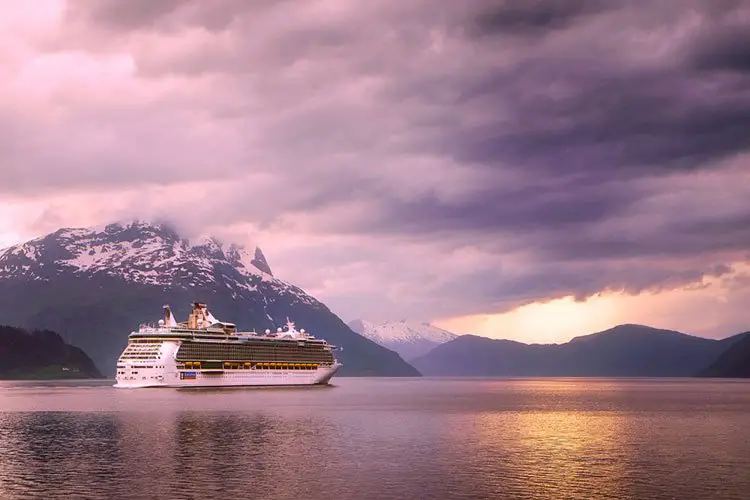
What Is A Cruise Ship?
A cruise ship is a luxurious passenger ship used for recreational and pleasure voyages and has all the amenities, entertainment options, activities, and attractions present only for the purpose of enhancing the passenger’s experience.
A cruise ship usually takes a round trip of a particular route that is assigned to it and unlike an ocean liner which merely carries passengers from one place to another. The journey of a cruise ship is may range from 2-3 days to even 14 days or more depending upon the itinerary. The vessel stops at different points which are usually exotic locations. Cruises can run internationally or locally and in seas and oceans as well as rivers.
What Is The Purpose Of A Cruise Ship?
Cruise ships today offer a wide range of amenities onboard which include casinos, shops, swimming pools, theatres, spas, gyms or fitness centers, libraries, buffet, lounges, clubs, tennis courts, basketball courts, infirmaries, ping pong tables, pool tables, bowling alleys, rock climbing walls, miniature golf courses, chain restaurants, obstacle courses, video arcades, etc. to name a few.
Hence, cruise ships can also be considered as 5-star hotels on boats.
A cruise ship vacation means that you don’t have to plan the logistics. A cruise ship itinerary usually includes multiple popular tourist destinations. As a tourist, you don’t have to plan, choose, and book different hotels or transportation. All these problems are non-existent when you choose a cruise vacation.
One more advantage of a cruise ship is that you board a cruise ship and unpack in your cabin once. After that, your ship will visit multiple destinations but won’t need to pack and unpack each time.
A Cruise ship is very enjoyable as you get to relax, take sunbathe, inhale invigorating ocean air, and socialize with people. These options may not be available in most vacations.
Cruise ships also have a plethora of entertainment and recreational options that keep every passenger of every age and gender busy and entertained for the entire journey.
There are many restaurants and eating options on a cruise ship which makes it a foodie’s delight.
Cruise ships are a great value for money!
Also read: 15 Largest Cruise Ships In The World!
What Are The Types Of Cruise Ships?
Cruise ships have evolved a lot in terms of amenities and purposes in the last few decades. There are many types of cruise ships designed to provide specialized cruise and excursion experiences in seas, oceans, rivers, and lakes.
Mainstream Cruise Ship
This is the most common and popular cruise ship which can be considered as floating resorts. These cruise ships are designed and equipped with all amenities which are generally present in resorts. A mainstream cruise ship has a capacity for 850 – 3,000 passengers and comes with all features, and services, like restaurants, bars, and pubs, nightclubs and discos, shopping areas, theatres and cinemas, galleries and museums, libraries, casinos, personal care areas with gyms and spas, swimming pools and other sports facilities.
Mega Cruise Ship
As the name suggests this ship can accommodate more than 3,000 persons. Mega ships are a new class of cruise vessels. They are highly sophisticated and technologically advanced ships
Ocean Cruise Ship
Ocean cruise ship is designed to be more stable and sturdier than other cruise ships as these sail in harsh conditions of long ocean excursions.
Luxury Cruise Ship
This ship is a highly luxurious vessel equipped with the highest level of comfort, amenities, and equipment. These generally cater to those who can afford to shell out a lot for exotic destinations and experiences.
Small Cruise Ship
The small cruise usually ranges from a Yacht size vessel to mid-size cruise ships which can accommodate a few hundred passengers. These are chosen by those tourists who like a more personalized and relaxing experience. The voyages are to not-so-famous destinations and provide specific services such as sea conventions, history cruises senior cruises, etc, and to places where larger cruises cannot go.
Adventure Cruise Ship
Adventure cruise ships typically go to remote destinations where larger ships cannot venture. These are smaller vessels but equipped luxuriously.
Expedition Cruise Ship
An expedition cruise ship provides exclusive experience such as expeditions to the Arctic or Antarctic region or biosphere reserves. These can accommodate fewer passengers than mainstream cruises and are not very luxurious. They though provide adequate safety and comfort features.
River Cruise Ship
These smaller ships can carry only a few hundred people at a time and navigate the rivers and inland waterways. They are luxuriously fitted with many amenities. Typical destinations are Amazon, Nile, Rhine, Siene, Volga, Mississippi, etc.
How Many Cruise Ships Are There In The World?
According to cruisemarketwatch.com , there are 314 ships as of December 2018 with a capacity of 537,000 passengers. Annualized total passengers carried worldwide will be 26.0 million
History Of Cruise Ships
The 20th century for remarkable growth in the cruise ship industry with countries like Britain and Germany leading the markets. Some of the most iconic ships of that time were Lucy Tanya, the Olympic, and of course, the Titanic .
During the first world war the building of new cruise ships was interrupted, and many old liners were converted into troop transports. Great Britain and the United States took over many German superliners. Cruise ships were considered as a luxury that was only accessible and exclusive to the rich and famous, high society people because of the high costs. Today, cruise ships are within the reach of almost everyone. However, they are still one of the most expensive types of boats. On average, a cruise ship costs about 150 dollars per person per night.
What Are Cruise Lines?
Companies operating and marketing cruise ships to the public are called cruise lines. Today there are several Cruise lines operating in the whole world some of which are specific to rivers.
Talking about oceans and sea, some of the biggest cruise lines in the world today are the Norwegian Cruise Line, Royal Caribbean, Star Cruises, MSC Cruises, Hapag-Lloyd Cruises, etc.
Some of the world’s biggest cruise ships have been listed below.
- Symphony of the Seas
- MS Harmony of the Seas
- The Allure of the Seas
- MS Oasis of the Seas
- MSC Meraviglia
- Quantum of the Seas
- Anthem of the Seas
- Ovation of the Seas
- Norwegian Bliss
- Norwegian Joy
- Norwegian Escape
- Liberty of the Seas
- Norwegian Epic
- Freedom of the Seas
- Independence of the Seas
Similar Posts
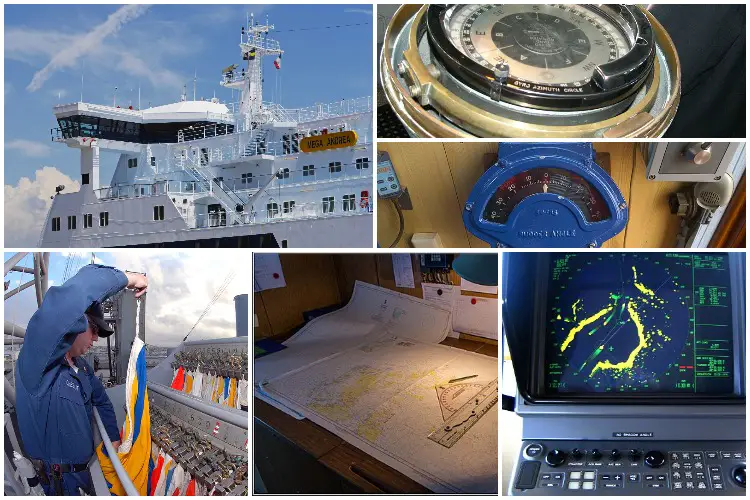
Types Of Marine Navigation Instruments, Tools And Equipment Used Onboard Ships
For centuries ships have been used for various purposes such as a means of transport, to carry cargo, and for battles, etc. Ships have been used for trade and travel since the earliest times. Even today, ships have not lost their importance. Ships have several advantages over other means of transport such as road and…
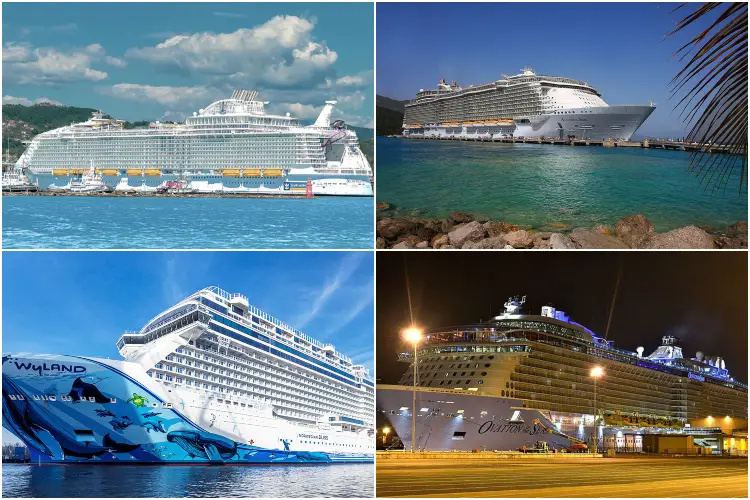
Top 15 Largest Cruise Ships
Cruise ships are getting bigger and better! And that’s why we at Maritime Manual have to constantly update our list of the top 15 largest cruise ships every year. Increasing popularity among travelers and fast-changing technology has spurred the shipping industry to come up with more luxurious and larger cruise ships with every conceivable amenities…
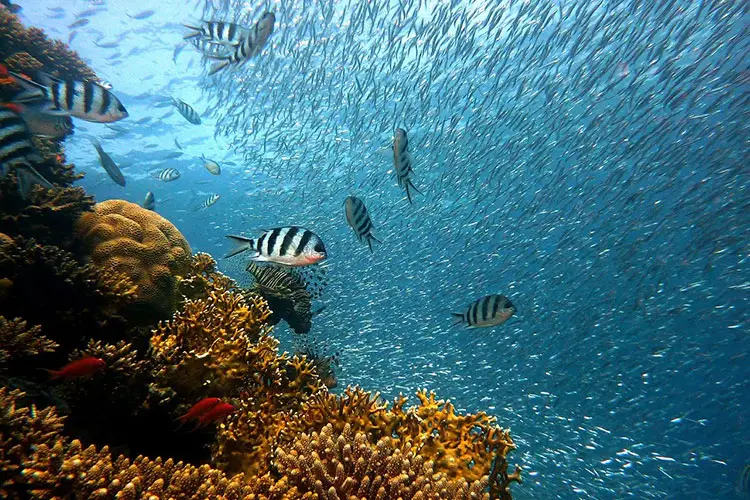
What Is An Ocean Biome?
What Is Ocean Biome? An ocean biome is the largest biotic unit on earth and is present in the ocean covering more than 70% of the earth. The Ocean biome or the marine biome includes the five main oceans of the earth that is the Pacific Ocean, the Atlantic Ocean, the Indian Ocean, the Southern…
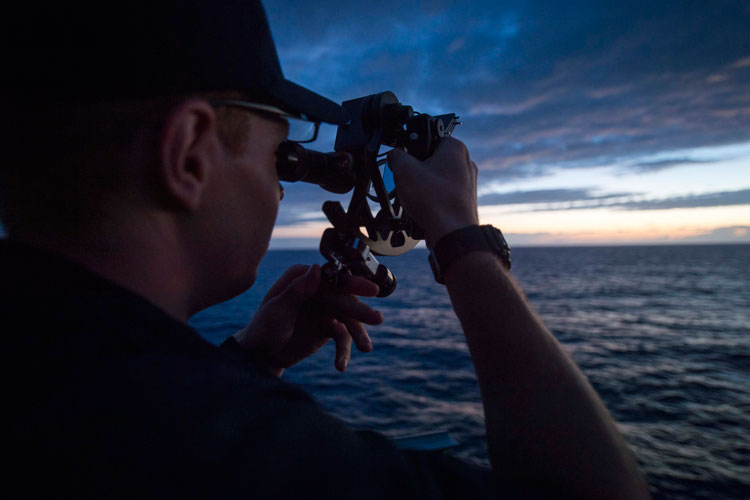
What Is A Marine Sextant?
All About Marine Sextant A Marine sextant is an instrument for measuring the angular distance between two visible objects, primarily used for measuring the angular distance between an astronomical object and the horizon in astronavigation. It is a complex system of mirrors that enhances the navigator’s ability to make measurements. The use of mirrors permits…
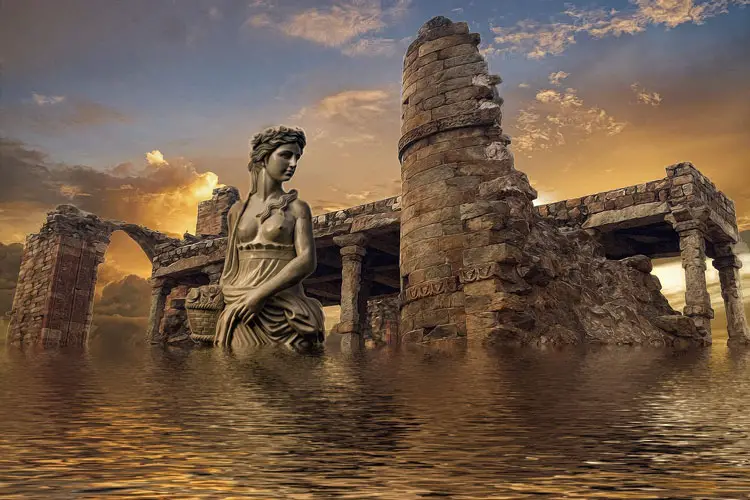
10 Unbelievable Facts About The Lost City of Atlantis
The Lost City Of Atlantis has been capturing the imagination of people and researchers for centuries. There are many myths and theories regarding this mysterious city about which there is no historical evidence. Even without any reliable information – written or otherwise, Atlantis has managed to become a part of popular culture. 10 Unbelievable Facts…
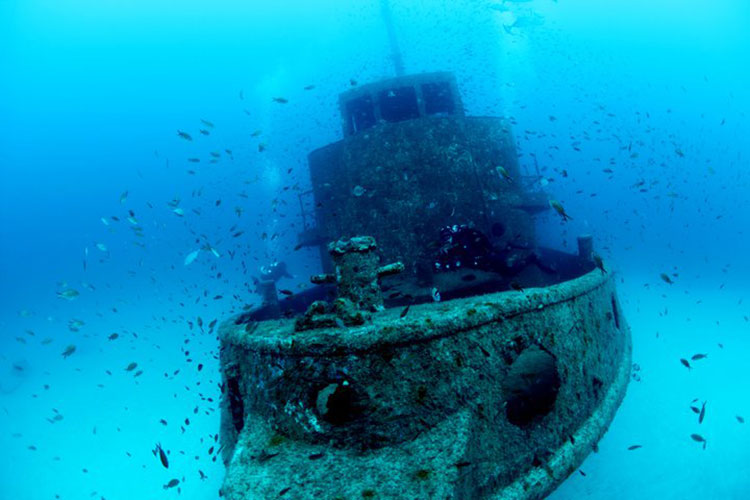
Top 12 Most Famous Sunken Ships
Ships have been a part of human history since time immemorial. Over the centuries, humans have managed to design different types of ships for serving different purposes such as transport, rescue, fishing, leisure, etc. Even today, ships are an indispensable part of human life. Thousands of ships set sail every day and several are under…
Leave a Reply Cancel reply
Your email address will not be published. Required fields are marked *
Save my name, email, and website in this browser for the next time I comment.
This website uses cookies to improve your experience. We'll assume you're ok with this, but you can opt-out if you wish. Read More
- Daily Crossword
- Word Puzzle
- Word Finder
- Word of the Day
- Synonym of the Day
- Word of the Year
- Language stories
- All featured
- Gender and sexuality
- All pop culture
- Writing hub
- Grammar essentials
- Commonly confused
- All writing tips
- Pop culture
- Writing tips
Advertisement
cruise ship
- a passenger ship built or used for pleasure cruises, usually taking passengers on an extended cruise with occasional calls in various places of interest.
Word History and Origins
Origin of cruise ship 1
Compare Meanings
How does cruise ship compare to similar and commonly confused words? Explore the most common comparisons:
- ocean liner vs. cruise ship
Example Sentences
“That one case went through our community here, almost like a cruise ship,” Garry says.
Canada has banned cruise ships for another year, dealing the industry another blow after the Covid-19 pandemic shuttered most sailings for the past year.
Consider the image of the Diamond Princess cruise ship berthed in Yokohama, Japan.
I remember seeing the news about a virus in China and on cruise ships thinking, “Wow, that’s terrible,” and never once thinking it could come to Michigan.
As the virus hopscotched across the globe, cruise ships became early symbols of the pandemic.
Nerd Cruise By Adam Rogers, Wired What 800 Nerds on a Cruise Ship Taught Me About Life, the Universe, and Snorkeling.
He told the court he called the retired captain to see exactly where he lived so he knew when to sound the cruise ship horn.
More than 150 passengers on a California cruise ship came down with norovirus, continuing a trend that happens every year.
One hopes we will never have to repeat such a careless cruise ship disaster to find out.
And then you would get flown on a private jet up to Alaska and go on his cruise ship for the party.
Another meeting was held in late August to discuss the problem with members of the cruise ship industry.
The cruise ship industry companies have not as yet been placed under a permit system.
The tourists enjoyed the sights, but they ate aboard their ship, which was evidently somewhat like a Caribbean cruise ship.
You say the 'Lachesis' and they say 'Oh, yes, the cruise ship.'
Related Words
- luxury liner
- ocean liner
Cruise Tourism
The cruise industry is a modern phenomenon but it rooted from the early years of the 19th century. As travel by ship was the only means to travel overseas. The Duke of Bridgewater was initiated to start water transport services from Manchester to London in 1772. His boat was used to carry passengers as well as goods.
In 1815 steamboats were developed and used to carry passengers and goods. To launch first cruise ship the credit goes to the king Charles IV of Sweden when he started his personal cruise ship in 1821 . In 1824 the first commercial cruise ship was started under the flag of Ireland. Gradually, steamship excursions became so famous and it resulted in the introduction of modern age cruise lines.
In 1938 the Peninsular and Orient steam was launched first long distance steamship services from India to the Far East. This company is still operating and has a good grasp of the cruise market. The Cunard ship company followed the P&O company and began regular services to the American Continent in 1840.
During the 2nd half of the 19th century, Britain dominated the cruise industry. However, this dominance has decreased in the later century with the advent of the substantial emigrant from Europe and the steady growth of US visitors to Europe.
Thomas Cook (the father of travel agency business ) stimulated the British tourists to visit North America. In 1866 he succeeds to operate first steamship excursion tour to the USA.
In the modern age, UK started first transatlantic lines ‘Titanic’ in 192 which was sold to the Newfound-land Islands in 1913. Second important cruise line ‘Queen marry’ was started in 1934 . It had 2000 passengers capacity along with 1100 crew members. It offered every facility for passengers such as comfort, safety, and entertainment. It was considered one of the great ocean liners.
In 1938 another larger sister ship Queen Elizabeth was launched by the same company. During the Second World War, these ships were used to carry British troops but after the war, their main business was to carry passengers across the Atlantic.
The year 1958 was the turning point in the steamship travel, as commercial jet aircraft has ended the dominance of steamship. By 1970’s steamship travel was only a curiosity. Due to less demand, high fuel prices and long duration of the journey all these resulted in the closing of many cruise company. Even many ship companies went bankrupt.
During 1980’s some large ships were converted into luxury liners, offering holidays to travelers who have money and time. Many cruise lines have taken the place of scheduled liner services.
The cruise industry is currently the fastest growing segment in the world tourism market and all tour operators now include cruises in their tour package.
Definitions of Cruise Tourism
The cruise tourism is an increasingly important part of the employment structure of advanced industrial nations as well as developing economies. Many of the cruise industries key players have made a significant contribution to the economic growth and development of the nation such as Star Cruises, Holland and American line Deluxe cruises. Crystal Cruises, Silversea Cruises, Princess Cruises, Royal Caribbean, and so forth.
Cruise tourism provides and offers food, beverage, accommodation, recreational, casino, shopping, and other services to the tourist. It is like an informal industry which makes an arrangement of various services i.e., cruise packages and combines these with air travel to attract the potential customer.
The cruise package includes a plenty of facilities designed to meet the specific requirement of passengers – such as accommodation, food, beverage, deck games, swimming pool, yoga classes, quiet lounges, sheltered dock, library, casino, disco films.
Many cruises include special interest themes – like astronomy, yoga, meditation, sequence dancing, classical music and many more.
Cruise Tour Package
A cruise tour package may be defined as a systematically planned return journey with entertainment and recreational facilities on board, and shore excursion. In other words, the cruise package is a pleasure an all-inclusive trip by boat or ship for specific days, to specific days, to specific destinations, and with a set price.
Cruises packages may be designed and planned for an individual group, families, FITs, business executives, honeymooners, and special interest tourists. Of course, these cruise packages are designed for cruise passengers. However, these could not be segregated from air travel and land arrangement.
Types of Cruise Tour Packages
If we see the cruise packages offered and marketed by tour operators and travel agencies , we find similar as well as more ingredients in cruise packages such as port handling charges, airport taxes, visa processing charges and so forth. Therefore, the elements or components of a cruise package may vary from tour company to company, destination to destination and from region to region.
On the basis of above discussion actual cruise industry environment the following main cruise packages are offered by cruise liners:
- Incentive Cruise Packages
- Group Packages
- Family Packages
- Business Cruise Package
- Honeymooners Package
- Special Interest Cruise Package
- Fly Cruise Package
Types of Cruise
Since the introduction of the first cruise in 1821, numbers of cruises came in the cruise industry. Some of them are still operating in the industry while others which were not attracting clients discarded from the industry. Thus, the following typology is based on sales, marketing and working conditions of the cruises:
Volume Cruise
As the name indicates, volume cruises concentrate on volume turnover. That is why these are called mass market cruises. 65 percent of all cruises are volume/mass market cruises. These cruises are very popular in the Caribbean sea, Asia Pacific and South East Asia.
In such cruises, accommodation and other services are comparable to the star hotel. Generally, these cruises emphasized two things i.e. Turnover and short-term passenger itinerary. These are further divided into three sub-categorized:
- Short term cruises – Normally two to five days.
- Standard cruises – For one-week duration.
- Large cruises – Duration is from the week to two weeks.
Premium Cruises
Premium cruises are the second largest segment of cruise industry accounting for mere than 40 percent of all cruise revenues. The duration of this cruise varies from one week to three months.
Due to this, these are known as upscale cruises. Their product and services are equivalent to its class resort, and hotel. Royal cruise, Star Cruises, Princess Cruises, Panama Canal Cruises are offering premium cruise service.
Luxury Cruises
Luxury cruises occupied a meager percentage of the cruise market. It may be due to its high-quality product and services and it focuses on long-haul itineraries for exotic destinations. These cruises are meant for elite people. The duration of itinerary may range from 6 months to 12 months.
In spite of high prices, these cruises are more popular among the tourists and honeymooners. Luxury cruises are operated by the Royal Caribbean cruises, Crystal Cruises, and Star cruises etc.
Specialty Cruises
These cruises are launched to cater the demands of specific interest passengers, such as newly married couple, whale watching, oceanography, scuba diving. The quality of products and services is comparatively low as other cruises. The duration of these cruises is very less but depending on the package.
Presently, there is more than 150 cruise ship with 90,000 cabins world over . The largest cruise lines is Royal Caribbean cruises liner (RCCL) with nine ships and have a capacity of 15,000 births. The Star Cruises is the 2nd largest cruise lines having five ships with 7000 births capacity. Followed by Deluxe cruise lines, Crystal Cruises, Radisson seven seas cruises, Seabourn cruises, Silversea cruise and princes cruises etc.
Significance of Cruise Industry For Tourism
The tourism industry in many countries of the world has been profoundly helped by the cruise sector to shape the tourism product and to satisfy the sophisticated travelers.
The relationship between the cruise industry and tourism industry is, therefore, a highly complex subject involving a mixture of socio-economic factors, technological factors, market pressures, government policies, management attitude ad tourist expectations.
The following points can be perceived pivotal for the significance of the cruise industry:
- Evolving cruise as a vacation option.
- Realizing the competitiveness.
- Development in MICE destinations.
- Image Conscious.
- Increasing the size of the cruise market.
- Alliances and Networking.
- Shifting tourist demands.
- Re-structuring ownership.
- Labor flexibility and Employment.
- Boom-bust cycles and tourism.
Process for Development of Cruise Tour Package
The development of air transportation and improvement in their technology in so far as safety, speed economy, and comfort are concerned to have admittedly hurt the cruise industry. However, steamship travel remains as today’s transportation of pleasure, relaxation, and comforts with service comparable to country’s best hotels and resorts.
The cruise industry is now a resort or hotel activities that must be promoted as floating hotel/resort, not for just vacation at sea but a romantic interlude, wedding anniversary, mind-dazzling, nightlife, resort cruise, and a pleasure of meeting new people.
Many thousands of rupees are spent annually by the cruise companies to promote their products and services directly or, through the tour operators and travel agents but a crucial question remains unanswered. What should be included in the cruise package? How it is to be marketed? What will be the core ingredients? In many cases, tour operators failed to find the right mix of cruise package for their clients.
Standard Components of Cruise Tour Package
Cruise packages are developed to all clients such as honeymooners, nature lovers, students, adventurers, fitness/health conscious, sport minded, music lovers, special interests and education professional etc. Thus, a cruise company has to consider a wide spectrum of market demands.
Therefore, the components of a cruise package will vary from client to client and company to company. However, the following main components or ingredients can be drawn from the cruise packages offered by the most cruise companies and tour operators:
- Air travel or land arrangements.
- Cruise segments Accommodation Food and beverage Entertainment and recreation Deck games Swimming pool Health clubs Casino Films Music-dances Entertainment facilities for children Quite lounges Sheltered decks
- Special Interest Theme Cricket Bridge Astronomy
- Education Library
- Other activities
Process of Cruise Tour Package Development
Developing cruises trips/tours, working with some other players; formulating effective marketing, managing and determining cost and price are the activities that are not easy to handle for the cruise company. However, if the manager approaches in a planned and systematic way, tour designing will become a simple, and easy task.
Cruise Tour Itinerary
A well-planned cruise tour itinerary identifies embarkation points, ports of calls, types of cabin, cruise facilities, meal services, shore excursions, tipping, and other services. Gradually, the cruise itinerary combined with air travel and land arrangement to make it more attractive and effective.
However, individuals needs cannot be overlooked. Thus, in developing cruise tour itinerary, tour planners/cruise planners normally considered the market forces, cruise industry environment, and cruise reference tools. Moreover, a cruise planner keeps in mind the following facts while designing cruise itinerary:
- Name of the Cruise
- Sailing date
- Destinations
- Port of Embarkation
- Port of Termination
- Client choice client budget
- Legal formalities
Types of Cruise Tour Itineraries
Cruise tour itineraries are broadly categorized in the following types:
- Short duration itineraries
- Medium-haul – Short and long duration itineraries (7 night, 10 nights and above)
- Long haul – Medium duration itineraries (7 months)
- Transatlantic and Round the world itineraries ( 6 to 12 months)
Cruise tour itineraries are not limited only to sea but river cruise itineraries can be developed. The main rivers of the cruise are Amazon, Mississippi, Yangtze Kiang, Hung He, Nile, and the Rhine, etc.
Determination of Cruise Tour Package Coast and Price
Determination of cost and price of a cruise tour is one of the most difficult tasks of a cruise manager/planner. What should be the exact cost? What should be the right margin? These are the two important question which a tour planner has to face. Total price must be perceived by the passenger to be reasonable.
The cruise planner must ensure about the cost. Thus, before determination of the cost of a cruise package tour planner considers the following factors:
- Length of Tour
- Types of accommodation
- Type and quality of facilities
- Position of cabin
- Density of ship
- Date of travel
- Govt. Policy
- Competitive forces
- Seasonality
A typical cruise package includes accommodation cost, meal cost, recreational and entertainment cost, activities for children and teenagers, port taxes, shore excursion cost, and airfare may also be a part of total cost. Thus, at first glance, it may seem an expensive package, but we must understand the cost represents not only the accommodation, Food, and transportation but also entertainment together with other services and opportunities to visit a foreign port.
Cruise prices vary among cruise companies, depending on various factors and quality of product and services. More importantly, price depends on the selection of itinerary and standard of qualities. In cruise, segment price is not the main criteria but the quality of services is important.
Thus, a cruise package must create value for money to repeat clients. Generally, cruise companies adopt a mix of pricing strategies such as:
- Cost-oriented pricing
- Market-oriented pricing
- Product line pricing
- Competitive or seasonal pricing
Cruise Tour Sales and Marketing
The selling of cruise tour ticket is substantially different from the selling of airline ticket. One of the most important features relating to this is that the airline industry is well organized and regulated as compared to the cruise industry. Today, selling cruises are becoming more easier and profitable than ever.
Due to competition, the cruise companies are offering more discounts and other promotional incentives to the passengers. Besides 15 percent commission, more incentives are offered to the tour operators or travel agencies by the cruise companies.
There is a minimum procedure involved in selling and booking cruise package. Like other means of transportation, cruise liner issue the ticket, and provide other information through cruise brochure such as accommodation, entertainment, travel insurance, foreign currency, travel tips, and so forth.
Thus, successful selling and booking steamship cruise requires knowledge of both passengers and cruise on which client will have the product services, comforts, and entertainment. Tour operators need certain information to book a cruise package about the client such as:
- Name of clients
- Duration of tour
- Date of sailing
- Cabin choice
- Meal option
- Entertainment and Recreational activities
- Address with e-mail and telephone no
- Other information which is mere relevant
After obtaining required information, tour operator negotiates with cruise lines/companies. He has various options – i.e. to select a cruise for any age group. A long cruise “ Round the World ” takes long-range planning while shorter cruise can be booked with 3 to 5 days or shorter notice.
Tour operators or a travel agency follow a well defined and designed procedure for booking a cruise. The process may vary from company to company and point to point, but it includes all most following steps:
Cruise Ticketing
Preparation and issue of cruise ticket is the last step in the process of cruise reservation. The cruise ticketing is mostly done by the cruise companies or by the tour operators/travel agencies who are authorized to hold stock and issue the ticket.
A cruise ticket is a legal contract between the cruise line and passenger, entitling him/her or groups, at a stated price, to travel and avail cruise facilities specified – i.e. cruise products or services during a set time. Thus, the acceptance of cruise ticket means acceptance of those terms and conditions which contained in the passage contract ticket.
A cruise ticket document includes or conditions the following items:
- Staterooms, inside, outside
- Food and Beverage
- Dining room seating
- Sports deck
- Entertainment
- Social life
- Children’s corner
- Teenager rooms
- Port of cell
- Date of issue
- Agent validation No.
- Address of tour operator
A passenger who misplaces his/her ticket may be denied the right to board, to use cruise products or services, and even maybe denied a refund.
145 Cruise Ship Terms and Meanings
Disclosure: This post may contain affiliate links. We may receive compensation when you purchase via my links at no cost to you. See my disclosure for more information.
If you’re new to cruising, you may have noticed there’s a whole world of cruise ship terms and meanings. If it’s your first cruise, it might take a minute to get the hang of the cruise lingo.
We’ve put together a handy glossary of essential cruising vocabulary you need to know before you step on board.
Table of Contents
Cruise Ship Terms
Ship terminology.
Ship: A ship is not a boat. Ships are large vessels intended for ocean or deep water transportation of cargo or passengers.
Cruise Ship: Cruise ships are large passenger vessels whose primary purpose is to transport passengers on leisurely vacations.
Ocean Liner: Their primary purpose is to transport cargo or passengers across seas. For a more in-depth article, visit our cruise ship vs. ocean liner comparison .
Sister Ship: Two or more ships of the same class or nearly identical design. For example, Oasis of the Seas and Allure of the Seas are sister ships.
Deck: A platform or section on a ship. Where buildings have floors, ships have decks.
The Bridge: The main control center of the ship. From here, the captains and officers have control over the entire operation of the vessel.
Itinerary: A sailing schedule with the route and destinations you will visit. The itinerary is viewable before you book but may change due to unexpected events or weather.
Atrium: The main lobby of the ship. Most cruise ship atriums are three or more decks high, and the location you first step onto a cruise ship. The atrium is the hub of the vessel, where you’ll often find elevators, stairs, photo booths, and the guest information desk.

Purser’s Desk: Often referred to as guest services, this is where guests can inquire about anything related to billing or ship information.
Deck Plan: A map of the cruise ship’s decks. Most ships have deck plans on each floor to help passengers find their way around the boat. Deck plans are incredibly important for navigating your way around the ship, especially for your first few days on board.
Lido Deck: The lido deck refers to the pool deck on a cruise ship. The name comes from the Italian word “lido,” which refers to a public outdoor swimming pool or beach. Accordingly, the cruise ship lido deck is home to one or more swimming pools, hot tubs, bars, and restaurants.
Gangway: A gangway is a narrow walkway used by passengers and crew to get on and off the cruise ship.
Muster Drill: The muster drill is a mandatory safety drill completed before sailing. The drill prepares guests for safe evacuation in the event of an emergency and familiarizes passengers with life vests, escape routes, and lifeboats. By law, the muster drill must be performed within 24 hours of departure.
Muster Station: Muster stations are where guests and crew meet in cases of emergency. The muster station is where you will find life vests and your assigned cruise ship lifeboat .
Daily Planner (cruise compass, bulletin, or newsletter): The daily planner goes by many names. It is where you will find the day’s scheduled activities. Many cruise lines have dedicated apps that allow passengers to see the day’s schedule from their devices.
Sailaway: Sailaway is the period of time that your cruise ship departs the cruise port. Cruise ships often host a Sailaway party to celebrate the cruise’s start.
Sailaway Party: Cruise lines often host a Sailaway party on the first night of the cruise to kick off the vacation. The party is generally located on the main pool deck or atrium with drinks, live music, and dancing.
Sea Day: A sea day is a full day when the ship doesn’t visit a port. Most cruises of a week or longer contain one or more sea days. But, they are by no means boring. On sea days, the cruise line will host plenty of scheduled events. If that’s not for you, you can simply relax by the pool.
Cruise Card: On most cruise ships, you’ll receive a cruise card that provides access to your stateroom and acts as a form of ID and payment around the vessel. The keycard eliminates the need to carry cash or credit cards around the ship.
Ocean Medallion: Ocean Medallion is a smart technology offered by Princess Cruises. Ocean Medallion replaces the traditional keycard with a wearable device. The wearable provides all of the same functions as a cruise card with several additional benefits.
Pier Runners: A name for passengers who are late to the cruise ship. You’ll find these unfortunate passengers running to the gangway as they race to make it onto the boat before the ship departs. Tip: Make sure you get back to the ship before the all-aboard time. The cruise ship will leave you behind if you’re late.

Lanyard: A lanyard is a common accessory used by cruise ship passengers to attach a cruise card. It’s both convenient and an excellent way to minimize the risk of losing your cruise card.
Rum Runners: Rum runners were people who, during the time of prohibition, traveled by sea to other countries to transport alcohol back to America. Today, a rum runner is a term used to describe a container used to sneak alcohol onto a cruise ship.
No Sail Order: In March 2020, the CDC introduced a no sail order that paused all cruise ship travel within the US. The no sail order was a temporary measure enacted to reduce the spread of Covid-19.
Cruise with Confidence: When cruising resumed following the Covid-19 pandemic, cruise lines introduced flexible cancelations policies. For most cruises, passengers could cancel up to 48 hours pre-cruise and receive full credit for a future cruise.
Warm Lay Up: During the period of suspended sailing, cruise lines could quickly bring a warm lay-up cruise ship back to service. These ships had reduced crew levels, fuel, food, and other essential items but were ready to return to service with short notice.
Cold Lay Up: A cold layup refers to a cruise ship that is fully shut down. Cruise lines shut down many cruise ships to save on costs during the no sail order. Ships in cold lay-up require more time to be brought back into service.
Funnel (or Stack): The funnel (or stack) refers to the exhaust on a cruise ship. It functions similarly to a chimney on a home and is used to expel engine exhaust. Most cruise ships have several funnels; however, typically, only one or two are functional (the rest are for aesthetics.)

Onboard Credit: An onboard credit is applied to your account and can be used on the ship to make purchases, such as drinks at the shop or souvenirs in the shops. Cruise lines and travel agents often offer onboard credit as an incentive to book, where you’ll receive a set dollar value when you book by a specific date.
Duty-Free: Duty-free refers to items that don’t have taxes. Duty-free purchases often must be declared when you return to the cruise terminal. If you are visiting from another country, you may need to declare duty-free items upon re-entry to your home country.
Godmother (or Godfather) : The Godmother (or Godmother) serves as a spokesperson for a cruise ship. As a tradition, the chosen individual is responsible for christening the ship and bestowing good luck to the new vessel.
Crossing: When a cruise ship sails across a large body of water. Examples include the Atlantic crossing, where a cruise ship may sail from Europe to America.
Double-Dip: When cruise-goers sail on back-to-back cruises. Sometimes one cruise just isn’t enough.
Maiden Voyage (Inaugural Sailing): The first sailing for a new cruise ship, or after a long pause (such as during repairs).
Dress Code: Cruise lines have dress codes that passengers must follow. Luxury cruise lines have strict policies, while most mainstream cruise lines allow casual wear at all times, except for formal nights.
Formal Night: Formal night is a traditional cruise ship experience where passengers dress up for a night of elegance. Some cruise lines have relaxed formal night dress codes , while Norwegian and Virgin don’t have any.
Planning Your Cruise
Embarkation: Embarkation is the process of passengers and crew members getting aboard a ship.
Embarkation Day : The first day of your cruise. It is one of the most exciting times of cruising, and the day you first step foot on the cruise ship.
Port of Departure: The port where your cruise ship will depart.
Disembarkation: The process of exiting the cruise ship. Often the saddest day of the cruise.
Port of Call: A port where your ship will stop.
Shore Excursion: An organized activity or event that passengers can attend in port. You can book shore excursions through the cruise line, a private tour company, or an independent tour operator.

Tender (Water Shuttle): There are some cruise ports where cruise ships can’t directly dock, usually because of a protected coral reef or the ship’s size. At these ports, the cruise ship will anchor a few minutes away from the port and shuttle passengers by tender boat.
Booking Terms
Onboard Booking: You can book your next cruise while on the ship of your current cruise. Cruise lines offer incentives to passengers to encourage onboard bookings. The incentives are one of the best ways to save money booking your next cruise. And, if you booked your current sailing through a travel agent, you can request that your booking is transferred to the agency.
Cruise Fare: This is the basic cost of the cruise. The cruise fare covers the cost of standard meals, accommodations, activities, and more. Many cruise lines offer basic wifi and drink packages bundled with the cruise fare.
Deposit: When you book a cruise, many cruise lines require a deposit to secure the booking. Each cruise line has different refund rules, and you may be unable to recoup the deposit if you cancel.
Final Payment: As the sailing date approaches, you will be required to make the final payment. The final payment is typically due within 70 to 90 days of the sale date. However, as policies vary, it’s always best to check with the cruise line.
Cruise Contract: You will be asked to sign a cruise contract when booking a cruise. The contract includes a set of terms and conditions that apply to passengers and the cruise line. The agreement is where you will find the refund policy, final payment date, and cancellation terms.
Gratuities: Gratuities, or tips, are customary on cruise vacations . Cruise lines charge gratuities on a daily, per-person basis. Most major cruise lines have automatic gratuities split among the hardworking staff, except bartenders and spa staff. If you don’t pay the gratuities in advance, they are charged to your onboard account and paid at the end of the cruise. Bartenders and spa staff receive tips through the gratuities charged on drinks, drink packages, and spa treatments.
Pre-paid Gratuities: Pre-paid gratuities are paid in advance of sailing. Paying in advance makes it easier to budget and plan for a cruise.
Solo Supplement: Most cruise ships charge a fee for solo bookings in regular staterooms. The added fee is known as a solo supplement. When a solo traveler books a cabin, the cruise line misses out on additional revenue from having two people in a stateroom.
All-Inclusive: All-inclusive cruises are great if you prefer to have all your expenses known before sailing. The all-inclusive definition varies by cruise line but typically includes gratuities, wifi, and a basic drink package.
Drink Package: Most cruise lines offer drink packages that entitle guests to order unlimited drinks. Drink packages typically have rules such as price limits and drink restrictions. If you don’t want to purchase the drink package, you can still purchase individual drinks from the bars, lounges, and restaurants.
Online Check-In: Before embarking, cruise ship passengers can complete online check-in and print any required documents.
Cabin Terminology
Cabin: Your room onboard the ship.
Stateroom: Another term for your room on the ship.

Interior Stateroom: This is a cabin located on a ship’s interior. Interior cabins don’t have windows (portholes) or balconies.
Oceanview Cabins: A cabin with a view of the ocean through a porthole or large window.
Balcony Cabins: As the name suggests, this is a stateroom with a balcony.

Suites: The largest and most luxurious cabin category on a cruise ship. Passengers who book suites often receive additional perks such as a butler, private lounge, bonus loyalty points, and free specialty dining.
Guarantee Cabin: This refers to booking a cabin category without choosing a specific room location. These cabins are lower priced, but with the drawback of having the location assigned by the cruise line. If you’re not picky about the location of your stateroom, guarantee cabins on cruise ships are a great way to save money on your cruise vacation.
Obstructed View Stateroom: You may have an ocean view or balcony cabin, but that doesn’t mean you’ll have unobstructed ocean views. Obstructed view staterooms have an object, such as equipment or a lifeboat, in the direct view of your window or balcony. These staterooms cost less than those with unobstructed views.

Veranda: Veranda is another word term used to describe a balcony. The word originates from the Hindi varandā, but it is related to the Spanish baranda, meaning “railing.”
French Balcony: French balconies are located on the interior of an outside-facing stateroom. They are often a result of modifications to older cruise ships or added as a lower category cabin. Though termed a balcony, it’s more of a wall-to-wall open window.
Virtual Balcony: Virtual balconies are wall-to-wall and floor-to-ceiling screens providing the illusion of a balcony for interior staterooms. They project real-time video of the outside, so your virtual balcony displays precisely what you would see from a real balcony.

Virtual Porthole: Like a virtual balcony, a virtual porthole projects real-time outside video. They provide interior cabins with the feeling of a porthole. Despite sounding tacky, they provide an extraordinarily realistic view.
Pullman Bed: Pullman beds are like little bunk beds where the top bed pulls down from the ceiling or wall above the main bed, accessible by a ladder. If you book with three or four people to a cabin, your cabin may have a Pullman bed.
Double Occupancy: Double occupancy indicates two people booked in a stateroom. The advertised cruise fare is often based on the double occupancy rate. Additionally, cruise lines often use double occupancy as the measurement of passenger capacity, as it is unrealistic that every stateroom would be booked at maximum capacity (e.x. two passengers staying in a cabin that could hold four.)
Single Occupancy: Most cruise lines charge a single occupancy rate to solo cruisers. The single occupancy rate adds a solo supplement. The total cruise fare for single occupancy is often near the cost of booking two people in a cabin.
Solo Cabins or Studio Cabins: Some cruise ships have staterooms dedicated to solo travelers. Solo cabins or studio cabins are comparably smaller than typical cabins, but they are cheaper as they forgo the solo supplement. The best cruise lines for solo cruisers feature solo staterooms.

Triple and Quad Cabins: As the name suggests, triple and quad cabins can accommodate three or four passengers.
Towel Animals: One of my favorite memories from cruising as a child is returning to the cabin and finding a beautiful towel animal on the bed. Room stewards often create cute towel creations to put a smile on your face. You’ll usually find them on family-oriented cruise lines .
Types of Cruises
Charter: People or tour operators may book out an entire ship to host a special event.
Repositioning Cruise: A sailing occurs when a cruise ship transfers to another part of the world. For example, a cruise ship offering Caribbean itineraries may reposition to the Mediterranean for two months. Repositioning cruises are often cheaper than regular itineraries as cruise lines look to fill the vessel to earn revenue from an expensive voyage.
World Cruise: As the name suggests, a world cruise offers an extensive itinerary that sails around the globe and visits several continents. World cruises may last anywhere from two to twelve months.
Canal Cruise: A type of cruise that sails through a canal. Popular canal cruises such as the Panama canal take passengers on a unique voyage through several ship locks.
Barge Cruise: The smallest-sized cruise ship available. They usually consist of six to sixteen people. The cruise acts as a floating hotel able to traverse very shallow and narrow waterways.
Expedition Cruise: Expedition cruises offer sailings to the most remote locations in the world. These cruises emphasize the journey, adventure, and experience with a special focus on adventurous shore excursions.

River Cruise: A river cruise is sailing along inland waterways. In our opinion, river cruising is totally underrated. We love the calmness of river sailing, intimate ships, and uniqueness of itineraries. If you’ve only sailed on ocean cruises, you should definitely take a look at river cruising.
Day Cruise: A cruise that sails for a limited number of hours and does not include an overnight stay. Day cruises are typically limited to media and press tours.
Transatlantic: A cruise that sails across the Atlantic. Before airplanes, transatlantic sailings were the only transportation between Europe and North America. The ocean liner Queen Mary 2 regularly sails traditional transatlantic voyages from South Hampton to New York.
Cruise to Nowhere: A cruise itinerary that consists only of sea days before returning. They are typically only a few days long and don’t call in any ports.
Closed-Loop Cruise: A closed-loop cruise starts and ends in the same port . For example, a voyage that departs and returns to Miami, Florida, is an example of a closed-loop cruise.
Open-Jaw Cruise: An open jaw cruise starts and ends at different ports. Passengers embark at one port and disembark in another. For example, a voyage that departs Seattle, Washington, and arrives in Ketchikan, Alaska, is an open-jaw cruise.

Cruise Ship Dining Terminology
Assigned Seating: Many cruise lines provide assigned tables in the main dining room. The assigned seating is usually dinner-specific.

Early and Late Dining: Some cruise lines with assigned seating split dining times into two seatings. The first and second seating is often referred to as early and late dining.
Open Dining (or Open Seating): Many cruise lines offer open seating, whereby passengers may eat in the main dining room without a specified time for seating. Norwegian Cruise Line only offers open dining, which they call Freestyle dining. Other cruise lines, such are Princess Cruises and Celebrity Cruises, provide passengers with the option of set dining times or open dining. While open dining offers more flexibility, you may need to wait in line for an empty table.
Specialty Restaurants: Specialty restaurants refer to alternative dining choices that aren’t included in the base cruise fare. Specialty restaurants offer an intimate dining experience with a better culinary experience. The ship charges the meal to your onboard account when eating at a specialty restaurant.

Maitre d’Hotel (Maitre d’, for short): The Maitre d’ is in charge of the restaurant on the ship. This person greets customers, supervises the restaurant staff, and ensures that the experience meets the highest quality standards.
Captain’s Table: As the name suggests, the captain’s table is a chance to enjoy dinner with the ship’s captain.
Ship Crew Member and Staff Terms
Captain: The ship’s captain holds the ultimate command and responsibility of the vessel. In addition to steering and navigating the boat, the captain is responsible for the safety of all passengers and crew.

Cruise Director: You’ll often find the cruise director leading activities around the ship. During your sailing, the cruise director acts as the face of the cruise, and it’s their job to be friendly and outgoing.
Cabin Steward or Cabin Attendant: The cabin steward is responsible for cleaning and maintaining your stateroom. These crew members work hard to keep your room tidy and clean for when you return.
Deckhand: The deckhand is responsible for maintaining the exterior of the ship. They are responsible for general cleaning and maintenance of the deck areas and ship gear. They are also the ones responsible for loading and unloading supplies and equipment.

Bosun (Boatswain): A bosun is the highest-ranking, non-officer role in the deck department. Among their responsibilities, a bosun supervises deckhands, coordinates work, coaches staff members, maintains ship appearance, and overseas the mooring and anchoring operations.
Purser: The purser is responsible for handling the ship’s finances. Specifically, the chief purser oversees the staff who manage money, passenger accounts, and guest services.
Porter: The porter is responsible for helping passengers with their luggage. They are employed by the port authority, not the ship.
Passenger-Crew Ratio: The ratio of the number of passengers to the crew. The ratio gives a quick feel for the quality of service on board a cruise ship. In theory, the lower the ratio, the better the service. A ratio of 1:1 (a ratio only seen on luxury ships) means that there is one crew member for every passenger on board the vessel. Ratios of 3:1 are considered good.
Cruise Terminal: The building where you check-in for your cruise and board your ship . Like how airplanes have airports, cruise ships have terminals or cruise ports.

Port: A maritime facility with loading areas for ships to load and unload passengers and cargo.
Home Port: The primary cruise port for a ship. The home port is the port where the cruise ship begins most cruise itineraries.
Cay (Pronounced “kay” ): A small, sandy island with a low elevation on the surface of a coral reef.
Marina: A dock or basin that provides mooring services for small boats and yachts.
Dry Dock: A dock that can be drained of water to allow for construction, maintenance, and repair work on ships.

Shipyard: A facility where ships are built and repaired.
Navigational Terms
Port: When facing towards the front (bow) of the ship, the port is on your left. If you face the back of the boat (aft), the port is on your right.
Starboard: When facing towards the front (bow) of the ship, the starboard is on your right. If you face the back of the boat (aft), the starboard is on your left.
Insider Tip
If you need help remembering port and starboard, check out our article: How to remember port and starboard on a cruise ship .
Bow/Forward: The front of the ship.
Stern: The rearmost part of the exterior of the ship.
Aft: The rearmost part of the interior of the ship.
Prime Meridian: Prime meridian is the earth’s zero of longitude (0º), which passes through Greenwich, England. Together with the anti-meridian, they divide the earth into two hemispheres.
Nautical Twilight (Nautical Dawn): Nautical twilight begins in the morning when the sun’s center is between 6 to 12 degrees below the horizon. During nautical twilight, the stars and horizon are visible, even on moonless nights, allowing sailors to take reliable star readings for navigational purposes.
Celestial Navigation: Navigation by observing the sun, moon, and stars. Before advancements in technology, celestial navigation was the primary method for sailors.
Nautical Terminology
Midship: The middle of a ship or boat.
Overall Length: The length of a ship from bow to stern.
Beam: A measure of the width of a ship or boat.
Gross Tonnage: A measure of a ship’s overall internal volume. Gross tonnage is determined by dividing by 100 the contents, in cubic feet, of the vessel’s enclosed spaces.
Wake: A moving ship generates a tace on the water’s surface. The frothy white water trailing a moving vessel is called the wake. Watching the ship wake as you sail away from the port can be mesmerizing.

Berth: The term berth has a dual meaning. The first is a name for a bed on a ship. The second is a space where a vessel may be moored.
Helm: The helm is the position from which the captain steers the vessel. It also refers to the lever or wheel that controls the rudder on a ship.
Hull: The main body or structure of a vessel. The hull includes the bottom, sides, and deck of the ship. The watertight hull is how cruise ships float .
Porthole: A small exterior window on a ship. Portholes are usually circular.
Mast: On a sailboat, the mast is a pole rising vertically from the hull, which serves to support the sail. There is only one mast on a small sailboat, but larger boats have several.

Mainsail: The largest and most important sail on a boat. On a square-rigged vessel, the mainsail is the lowest and largest sail on the mast.
Boom: The boom is a thick pole that extends at a 90-degree angle from the mast. It anchors the bottom of the sail and provides sailors with greater control and maneuverability.
Rudder: The rudder is an underwater verticle blade positioned at the vessel’s stern. It is controlled at the helm and is the primary method of steering. When the captain turns the wheel, it rotates the rudder. As the rudder rotates, the vessel’s head turns in the same direction.

Mooring: Refers to a permanent structure to which a ship can attach.
Docking: The act of mooring a ship at a dock.
Latitude: A geographic coordinate that specifies the north-south position on the earth’s surface. Latitude lines run in parallel lines from east to west. When looking at a globe, latitude lines are horizontal. The latitude angle ranges from 0° at the equator to 90° at the poles.
Longitude: A geographic coordinate that specifies the east-west position on the earth’s surface. Latitude lines run in parallel lines from north to south. When looking at the planet, longitude lines run vertically.
Equator: The equator is a latitude circle dividing the earth into the Northern and Southern hemispheres. It is located exactly halfway between the North and South poles. The equator’s location is at 0 degrees latitude.
Flag Country: The country where the ship is registered. You can quickly identify the ship’s flag country by looking at the ship’s stern, where you’ll usually find a flag and the country’s name.
If you are curious about why cruise ships have a different flag country, check out our article: Why do cruise ships sail under foreign flags?
Knots: Knots are a unit of speed used by ships and are short for nautical miles per hour. One knot is equivalent to 1.15 land miles per hour. Cruise ships have cruising speeds of around 22 knots .
Provisions: Refers to supplies needed on the ship
Lock: A device used to raise and lower ships between stretches of water at different levels.
Zodiacs: Small inflatable boats used for water bases shore excursions. Zodiacs are named after the company that invented them. The inflatable boats were created in the 1930s for the military but are now commonly used in tourism.
Stabilizers: Stabilizers are fin-like devices mounted to the ship’s hull beneath the waterline. They help counter the roll of a vessel due to waves or wind and provide a smoother ride for passengers.

Anchor: A heavy object attached to a rope or chain used to keep a vessel stationary.
Galley: The galley is another name for the kitchen of the ship. Many cruise lines offer tours of the galley, which provide a glimpse into the behind-the-scenes world hidden from passengers.
Cruise Industry Acronyms
OBC (Onboard Credit): Onboard credit can be used like cash for purchases on the ship. You might receive onboard credits as an incentive offered by a travel agent or cruise line.
GTY (Guarantee Cabin): An abbreviation for guarantee cabin (see the definition above for guarantee cabins).
FCC (Future Cruise Credit): Future cruise credits work little like store credits. Cruise lines offer FCCs in place of refunds which can be redeemed when booking a new sailing. Always read the fine print as they almost always have expiry dates.
TA: Short for a travel agent.
Cruise Industry Organizations
CLIA: The Cruise Line International Association is the world’s largest cruise industry trade association based on the number of passenger ships operated by CLIA members. Among other responsibilities, the CLIA’s focus is to set standards for cruise lines and represent the interests of the cruise industry. According to their website , “CLIA is the global organization that fosters our members’ success by advocating, educating, and promoting the common interests of the cruise community.”
NOAA: The National Oceanic and Atmospheric Association is part of the US Department of Commerce. Their responsibilities include “daily weather forecasts, severe storm warnings, and climate monitoring to fisheries management, coastal restoration and supporting marine commerce.”
Marcello De Lio
Trending now

- Cambridge Dictionary +Plus
Meaning of cruise ship in English
Your browser doesn't support HTML5 audio
- banana boat
- container ship
- semi-submersible
- submersible
- transport ship
- Nobody lives in Antarctica, except for a few scientists, but people still visit the spectacular landscape of ice, snow, glaciers, and icebergs from the comfort of a cruise ship!
- They arrive on cruise ships or buses, see the sights quickly, and spend very little money on hotels or restaurants.
- Working on a cruise ship can be a great way to meet people from all over the world and explore the globe.
Examples of cruise ship
Translations of cruise ship.
Get a quick, free translation!

Word of the Day
bank holiday
an official holiday when banks and most businesses are closed for a day

Trial, judge, and jury: talking about what happens when a criminal is caught

Learn more with +Plus
- Recent and Recommended {{#preferredDictionaries}} {{name}} {{/preferredDictionaries}}
- Definitions Clear explanations of natural written and spoken English English Learner’s Dictionary Essential British English Essential American English
- Grammar and thesaurus Usage explanations of natural written and spoken English Grammar Thesaurus
- Pronunciation British and American pronunciations with audio English Pronunciation
- English–Chinese (Simplified) Chinese (Simplified)–English
- English–Chinese (Traditional) Chinese (Traditional)–English
- English–Dutch Dutch–English
- English–French French–English
- English–German German–English
- English–Indonesian Indonesian–English
- English–Italian Italian–English
- English–Japanese Japanese–English
- English–Norwegian Norwegian–English
- English–Polish Polish–English
- English–Portuguese Portuguese–English
- English–Spanish Spanish–English
- English–Swedish Swedish–English
- Dictionary +Plus Word Lists
- English Noun
- Translations
- All translations
To add cruise ship to a word list please sign up or log in.
Add cruise ship to one of your lists below, or create a new one.
{{message}}
Something went wrong.
There was a problem sending your report.

Last Body Found From Sunken Sicily Superyacht, All 6 Missing Guests Reported Dead

Adani Krishnapatnam Port Launches India’s Most Advanced Cargo Handling System

World’s First Commercial-Use Ammonia-Fueled Vessel Receives ClassNK Certification

China’s Largest Ports Set To Establish Green Shipping Corridors

Different Types of Cruise Ships Explained
We are often left in awe looking at the magnificent engineering marvels called the cruise ships. In our previous article, we had a detailed discussion about the differences between cruise ships and their former counterparts called ocean liners, which were once the only reliable means of global passenger transportation before the revolutionizing advent of aviation.
The indispensability of passenger shipping as the monopoly in public intercontinental travel gradually waned away roughly coinciding with the same timeline as the concept of ocean liners saw a departure, thanks to the flourishing of the aviation sector, and cruise ships became increasingly synonymous with passenger vessels .
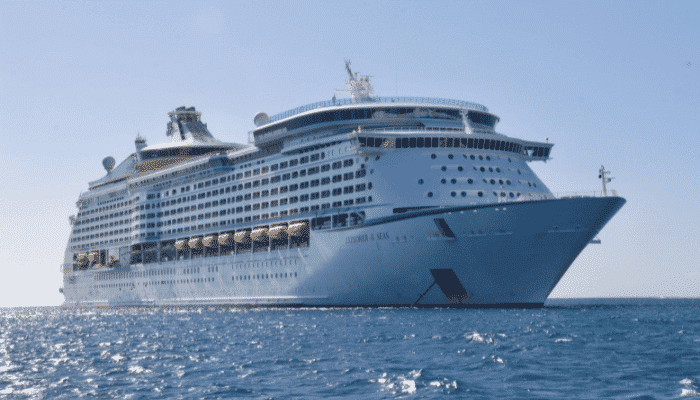
As contrary to ocean liners which were commercial vessels for passenger transportation and sometimes carriage of cargo, mail services and other utilities regularly, cruise vessels are mostly for pleasure purposes and tourism.
They are solely dedicated to the hospitality and amenities of the passengers while onboard for vacation, excursions or pleasure. While we have described the differences between ocean liners and cruisers, let us now look at the different types of cruise ships that commonly exist.
Different Sizes of Cruise Ships
Cruise ships can be of various types and sizes. Speaking of sizes, like other cargo or general-purpose ships, passenger ships can be categorized as being of multiple sizes depending on operations, service location, purpose, passenger preference, and overall business scenario.
Furthermore, the size of the vessel is a simple indicator of the number of passengers it can sustain onboard and the extent of the facilities and amenities it can cater to.
A particular cruise line providing passenger services can also have multiple sizes of ships in its fleet based on the requirements.
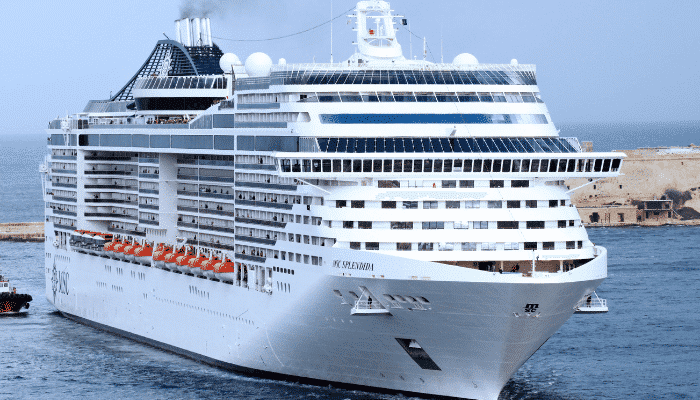
For the past decades, cruise ships have increased considerably in size and have evolved to accommodate a large number of passengers and at the same time provide a plethora of modern amenities which could not have been envisaged before.
Based on sizes and carrying capacity, cruise ships can be categorized into the following types:
Mega Cruise Ships
These are the largest of their kind and are known to accommodate more than 5000 passengers on board! When ocean liners were still predominant, cruise ships were seldom known to exceed 50000 GT in terms of their size. However, as said before, over the years with improved technology and innovation, cruise ship sizes have increased manifold.
In terms of their tonnage capacity, mega-cruise ships are very much above 135000 GT. Currently, there are more than 50 cruise ships in service having over 135000 Gt and are classified under Mega Cruise Ships. They are often distinguished by their large hull and towering superstructure sizes.
The largest designated cruise ship as of present-day is the very recent Wonder of the Seas, with a whopping gross tonnage of 236860, a length of over 360 meters, a width of 65 meters, and can accommodate nearly 7000 passengers on board!
Launched in January 2022, it is slated to create history by embarking on its maiden voyage in March. In concordance with their majestic sizes, Mega Cruise Ships house state-of-the-art facilities for passenger services, luxury, and recreation, drawing parallels to ultramodern five or seven-star rated hotels.
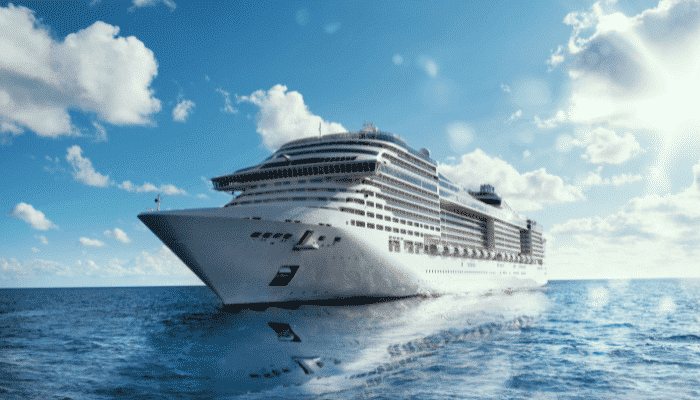
From swimming pools to movie theatres, indoor game infrastructures to world-class health centres, casinos to large restaurants and pubs, conference halls to banquets, shopping malls to pavilions, commodious suite rooms to wellness clubs, the litany can be enough to motivate holiday-seekers to amass more on their savings and plan a dream vacation.
Moreover, it is obvious that other than catering to passenger recreation and comfort, they also offer essential services like hospitals and dispensaries on a round-the-clock basis for any unwarranted needs that may arise.
Other biggest names following Wonder of the Seas are Symphony of the Seas, which held the top spot for being the largest cruise ship till last year, Harmony of the Seas, which had its realm from 2016 to 2018, Oasis of the Seas, which ruled the lot for 7 long years from 2009 to 2016, and Allure of the Seas, which became a joint claimer to the throne since its maiden voyage just a year after its predecessor (in 2010), with comparable size and capacity (very slightly less in GT).
All these are Oasis-class sister ships with GT over 200000 and operate under the parent organization, Royal Caribbean International line, an industry leader in cruise shipping tourism and hospitality headquartered in Miami, Florida, United States.
Large Cruise Ships
These are somewhat smaller than Mega Cruise Ships and can hold anywhere between 2500 to 3500 passengers for all normal purposes. In terms of tonnage capacity, they are 10000 GT or more but mostly less than 135000 GT.
Voyager of the Seas from the slightly old Voyager-class, also owned by Royal Caribbean, is an acclaimed ship of this category, but with a borderline capacity of around 3600 passengers and approximately 137000 GT, and an overall length of 310 meters, it is also often interchangeably deemed as pertaining to the category of Mega Cruise Ships.
Similar are the cases with MSC Divina, of the Fantasia-class, having 140000 GT and 3500-passenger capacity, and another recent vessel Costa Venezia, a Vista-class cruise ship, having a GT of exactly 135000 and a passenger capacity of over 4000, quite above the demarcating line for large cruisers.
Other notable names amongst many include Crown Princess (2006) belonging to the Crown-class, having 113500 GT, Celebrity Solstice from Solstice-class, rated over 120000 GT and 2850-passenger capacity, and MS Koningsdam which roughly has a capacity of just 10000 GT can hold up to 2650 passengers with doubled occupancy.
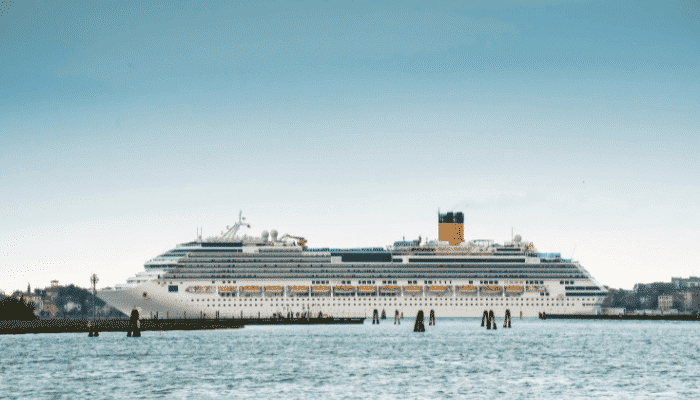
Large cruise ships can be considered as relatively smaller forms of their modern, mega variants, and started coming into being over two decades back at the turn of the century. However, like the examples cited, modern-day cruisers are commonly built in this size range with more advancements in terms of technology, design, luxury, and amenities.
Cruise ships, since mostly dedicated to tours and pleasure and seldom encounter adverse mid-sea weather conditions, can have some slack in terms of powering and structural requirements as compared to their predecessors, ocean liners.
But coming-of-age cruisers, mostly mega and large ones, have broken such conventions and have showcased significant developments.
Priorities for passenger safety and comfort have seen a sharp uptick increasingly over time.
Furthermore, with the global economy rapidly changing in a direction such that the several affluent sections of the society have continued to become richer, the predilection for cruise travel for leisure has garnered more popularity.
This has converted to more profits for cruise lines, who have also taken the opportunity to rework their business models to continue with this lucrative drive by not only providing more appealing facilities to their clientele but also stepping upon their services in terms of frequent tours and venturing into deeper territories and newer destinations across longer distances.
Hence, this has led to the modern bigger fleet having sturdier structures, escalated design efficiency, and of course, enhanced propulsive applications.
Midsized cruise ships
They are smaller than their larger counterparts, appear like their somewhat scaled-down versions, and can hold around 1500-2500 passengers. These ships have GTs of less than 100000 and more than 50000. Large global shipping lines do not go less than this category.
Likewise, they are also replete with most of the amenities and facilities sought for, though on a comparatively lesser scale. They may occasionally ply between continents and oceans but mostly travel on an intracontinental country to country basis or between different ports of call in a country.
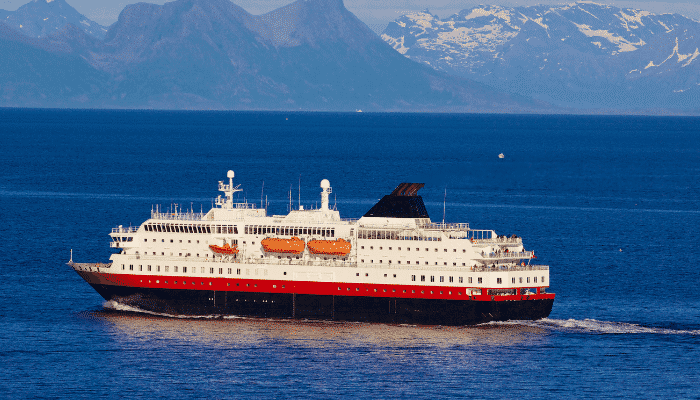
In terms of powering and structure, they are also on the lower side of bigger vessels but aesthetically they are equally attractive. A large number of vessels under this category are in operation globally. Carnival Spirit, having a tonnage of 88500 GT and a complement of over 2100 passengers, and Pacific Explorer, of approximately over 77000 GT and 2000-passenger capacity, both owned by Carnival Plc., are popular vessels in this category.
Smaller Midsized Cruise Ships
These ships can also be considered on the lower spectrum of midsized cruisers. Mostly similar, they have tonnages more or less around 50000 GT or lower and can accommodate 800-1500 passengers. They are mostly intended for intracontinental or intranational travel and do not venture into very high seas. They are also capable to travel in shallow drafts like rivers, canals/channels or lakes apart from seas.
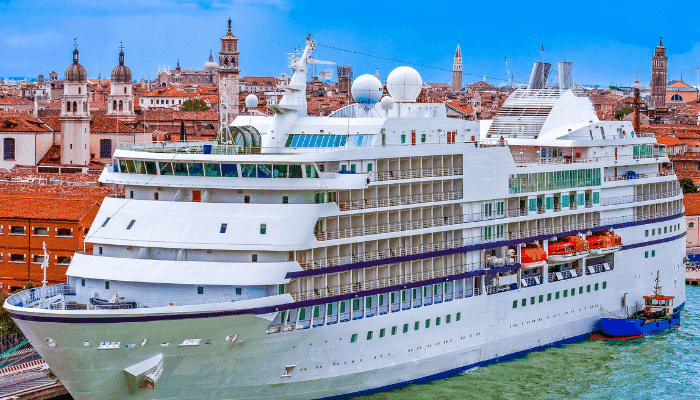
They also feature passenger pleasure and recreation attributes, but on a much-reduced scale, like small pools, indoor gaming rooms, dining and party halls, restaurants, bars, fitness centres, card rooms, conference lounges, kids’ game zones, etc.
There are numerous vessels of this type all around the world without any widely notable names. Viking Star-class Sister ships Viking Sea, Viking Star and Viking Sky, operated by Viking Ocean Cruises, and having slightly less than 50000 GT are some frontrunners in this category.
Small Cruise Ships
Any cruise vessel having a passenger-carrying capacity of less than 700-800 are coined as a small cruise ship. These ships ply in rivers, estuaries, channels, canals, confined water bodies like lakes, and sometimes in seas along or near to the coast within a specified limit.
As expected, these vessels are not structurally and functionally fit to venture into deep seas. Different kinds of bodies from liners to regional or national tourism providers operate these vessels on a time-to-time basis. The duration of a voyage in these cruisers range from a few hours to at most a day or two. As for small cruisers, the facilities onboard are limited and depends on the size of the vessel and operationality.
For larger vessels on the upper side of the capacity spectrum, for instance, 500-800, amenities for luxury and entertainment are present, though not on a scale similar to supreme level cruise ships. For even smaller cruisers with a passenger capacity of around 100-200 or lesser, most of the amenities are absent and mostly operate on an hourly basis to or from a destination or are rented out for some special occasions.
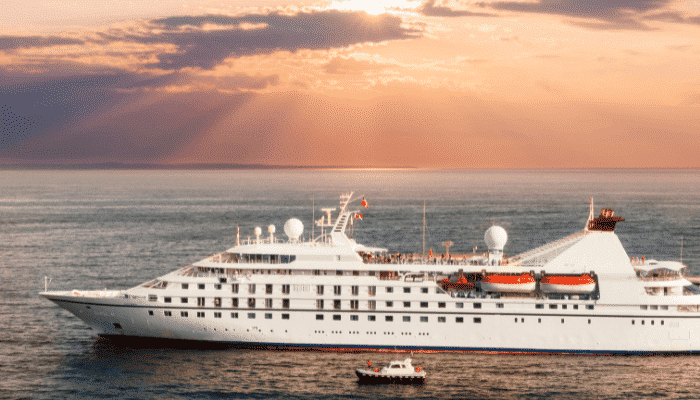
Often, they have a high demand and run on a rush booking order due to their small size and low, attractive fares. India has plenty of these vessels often in coastal areas like Mumbai, Chennai, Cochin or popular tourist destinations like Goa or the world’s largest riverine delta and mangrove reserve, Sundarbans in West Bengal. Ferries, which are exclusively referred to as small to moderate-sized vessels for carrying passengers, often along with cars and vehicles across a body of water, can be considered to belong to the last two categories.
Tonnages for ferries vary widely and can be anything as significant as over 50000 GT or as low as hardly 1000 GT. They may be intended for point-to-point or round trips with or without stops. Ferries comprise a significant part of the public transport system in several places.
As alluded to in the previous article, the concept of ferries was first conceived in Istanbul during the 19th century and can be rightfully considered as being precursors to the widespread popularization of modern-day cruise ships superseding the era of ocean liners.
Types of Cruise Ships Based on Purpose
Though cruisers are primarily categorized based on sizes, they may also be divided based on purpose, operation, and utilities.
Mainstream Cruise Ships
These types of cruise ships are the vast majority of all cruise ships that carry passengers for leisure and tours. In a broad sense, these cruisers can be anything between mega to smaller midsized with differences as described above.
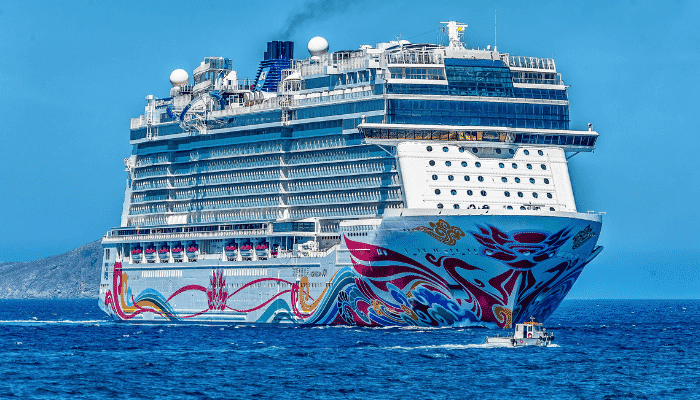
Some also tend to further categorize these vessels based on the degree of luxury and amenities from ultra-premium to semi-deluxe. They can be oceangoing, coastal or river-plying and can cater to a wide range of trips of varying durations as explained above.
Adventure Cruise Ships
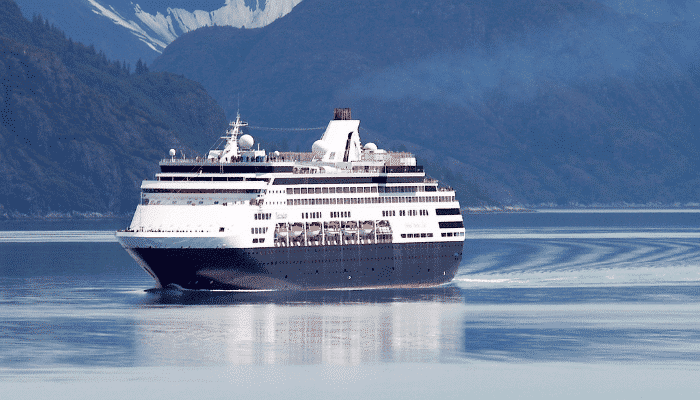
These are customized and bespoke small vessels for adventure lovers. Most of these vessels are either privately owned or are lent by agencies or dealers at certain rates. Often people set out in groups in these 10-50 passenger-capacity vessels for a myriad kinds of activities from whale watching to exploring reefs and islands. Though strictly not permitted to venture beyond certain sea limits, concerned authorities may sometimes give extra relaxations looking at sea and weather conditions or the ‘fitness’ of the vessel.
River Cruises
They are shallow-draft and low-width vessels belonging to the small cruiser category and are capable of plying in rivers for passenger tours and pleasure. They are mostly for an hourly basis and operate daily.
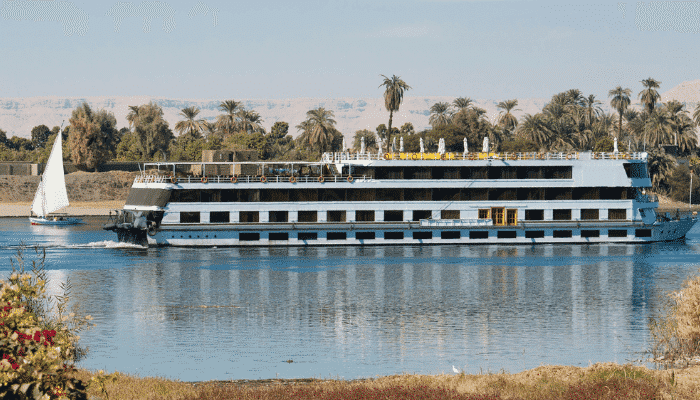
Due to their small sizes, they do not pose a major obstruction to river traffic and can manoeuvre easily when required. Other than the iconic Venice in Italy, famous rivers around the world like Nile, Amazon, Hudson, Thames and Danube offer cruise services regularly.
Hotel Ships
They mainly remain afloat in water or travel small distances and are chiefly floating hotels for a luxury experience. Most hotel ships are on rivers or seasides hemming cities and popular tourist destinations. They are generally not very big but sometimes can be exceptions when converted from large vessels out-of-service.
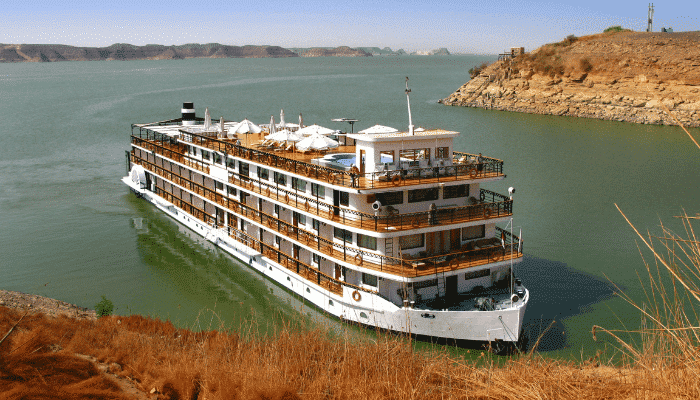
For example, Queen Elizabeth 2, which was the last oil-and-steam fired ocean liner of its kind, has been converted to a massive luxury floating hotel in Dubai after her retirement in 2008 following 40 years of operation. When on a sea coast, they remain anchored to a particular place as they are not deemed to sail. But on rivers, because of the low depth and calmness of the water, they can travel as well.
Expedition Cruises
They are specially designed vessels for venturing into the most uncharted and inhospitable places on earth like the polar regions. They are built as per ice-class regulations and everything from powering to systems are incorporated in such a way that they can sustain in harsh conditions. Such cruises are limited and only specifically authorized people are permitted to travel to such extreme locations.
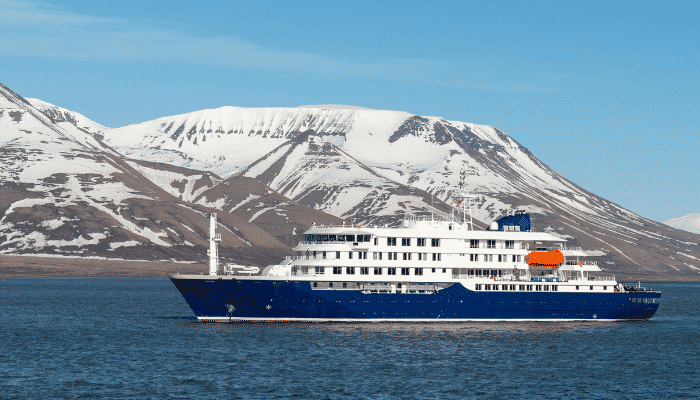
Yachts and private crafts: Such vessels are privately owned by affluent sections of the society who prefer to spend their leisure time in the water. Usually, they are quite small in size and are suited to accommodate around 20-30 people at most within the owner’s family or close circles.
You might also like to read:
- Top 10 Largest Cruise Ships in 2022
- Top 10 Most Expensive Cruise Ships in 2022
- How Are Cruise Ships Powered?
- How Do Cruise Ships Get Fresh Water?
- 8 Ways Cruise Ships Can Cause Marine Pollution
Disclaimer : The information contained in this website is for general information purposes only. While we endeavour to keep the information up to date and correct, we make no representations or warranties of any kind, express or implied, about the completeness, accuracy, reliability, suitability or availability with respect to the website or the information, products, services, or related graphics contained on the website for any purpose. Any reliance you place on such information is therefore strictly at your own risk.
In no event will we be liable for any loss or damage including without limitation, indirect or consequential loss or damage, or any loss or damage whatsoever arising from loss of data or profits arising out of, or in connection with, the use of this website.

About Author
Subhodeep is a Naval Architecture and Ocean Engineering graduate. Interested in the intricacies of marine structures and goal-based design aspects, he is dedicated to sharing and propagation of common technical knowledge within this sector, which, at this very moment, requires a turnabout to flourish back to its old glory.
Read More Articles By This Author >

Do you have info to share with us ? Suggest a correction
Related Articles
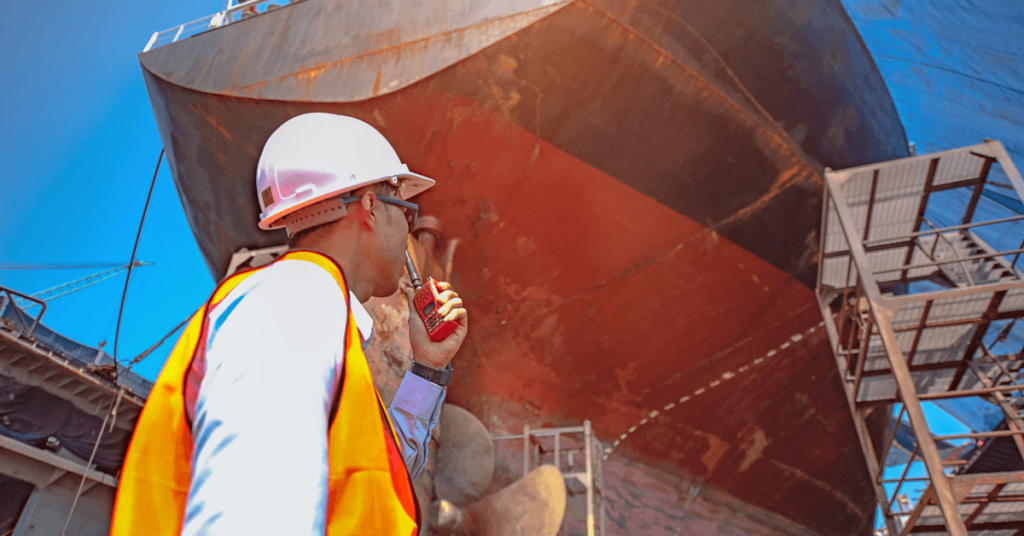
9 New Aspects of IACS Harmonised Common Structural Rules (CSR) For Ships
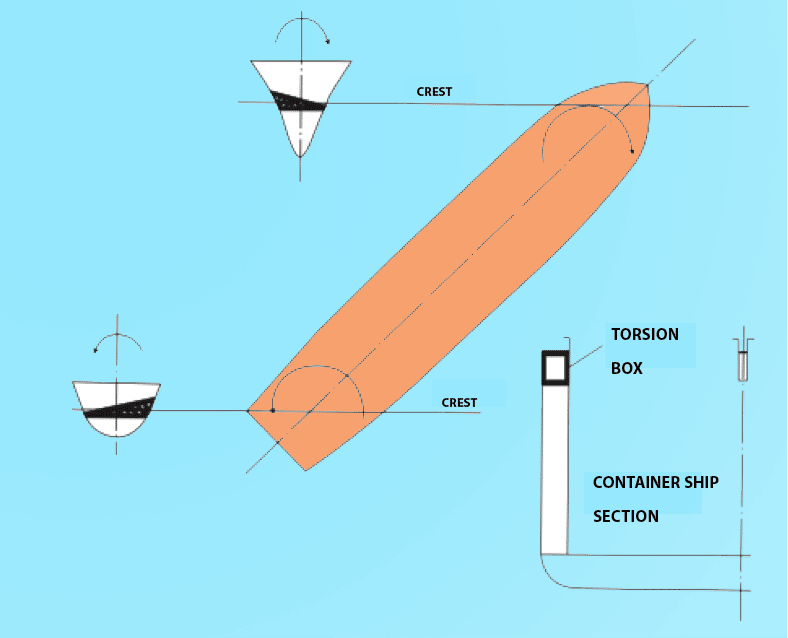
What Is The Purpose Of “Torsion Box” In Ships?
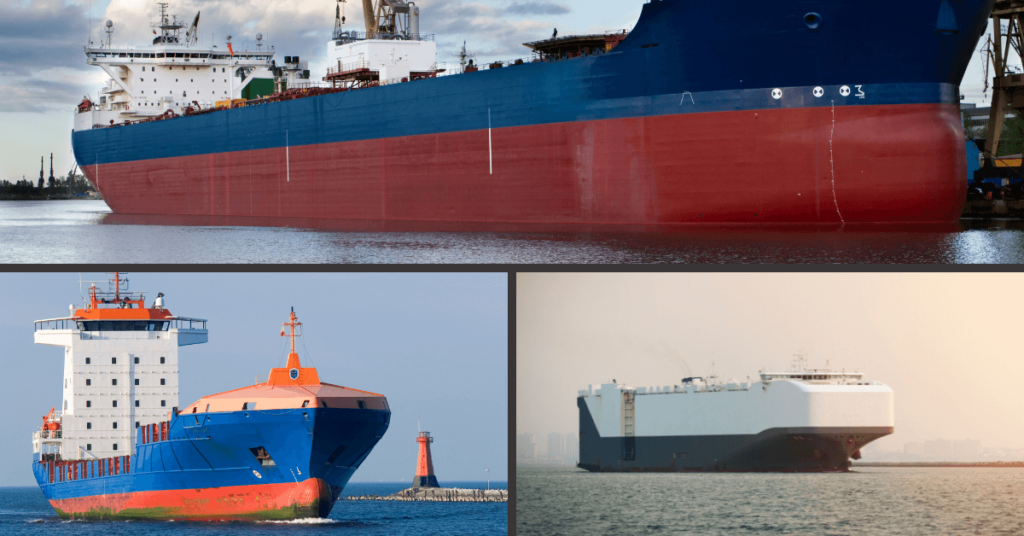
Types of Bow Designs Used For Ships
Daily maritime news, straight to your inbox.
Sign Up To Get Daily Newsletters
Join over 60k+ people who read our daily newsletters
By subscribing, you agree to our Privacy Policy and may receive occasional deal communications; you can unsubscribe anytime.

BE THE FIRST TO COMMENT
Leave a reply.
Your email address will not be published. Required fields are marked *
Subscribe to Marine Insight Daily Newsletter
" * " indicates required fields
Marine Engineering
Marine Engine Air Compressor Marine Boiler Oily Water Separator Marine Electrical Ship Generator Ship Stabilizer
Nautical Science
Mooring Bridge Watchkeeping Ship Manoeuvring Nautical Charts Anchoring Nautical Equipment Shipboard Guidelines
Explore
Free Maritime eBooks Premium Maritime eBooks Marine Safety Financial Planning Marine Careers Maritime Law Ship Dry Dock
Shipping News Maritime Reports Videos Maritime Piracy Offshore Safety Of Life At Sea (SOLAS) MARPOL

- Food & Drink
- How to Plan
- Shore Excursions
- Onboard Activities
- What to Expect
Ocean Lingo: Glossary of Cruise Ship Terms
By Carnival Cruise Line
If you’re a newbie to cruising culture, take a few minutes to learn the cruise ship lingo. Knowing the language both on board and on shore will make you feel more at ease on your very first cruise . We’ve compiled a list of the most essential terms for you to be familiar with before you step on board.
From knowing the ins and outs of stateroom design to understanding cruise ship nautical terms, you’ll be ready to hit the waves with confidence.
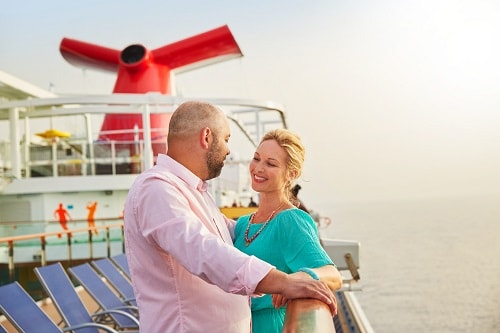
Planning Your Cruise
- Crossing: A voyage across the water – in other words, a cruise is a crossing. For example, if you take a cruise to Europe , you can depart from New York and cross to ports of call, including Northern Ireland .
- Departure port/embarkation port: Both of these terms refer to the port or location where your cruise begins and ends . Carnival has many departure ports in the United States. For example, you can cruise to the Western Caribbean from the departure port of Mobile, Alabama .
- Disembarkation: This is when you leave the ship at the end of your trip.
- Embarkation: It’s when you board your cruise ship at the beginning of your trip.
- Port of call: A port of call is a destination on your cruise and where you’ll likely be able to enjoy shore excursions. For example, if you take a cruise to Mexico , you can depart from one of three ports in California and visit multiple ports of call in one trip, including Cozumel , Costa Maya and Mahogany Bay .
- Shore excursion: A shore excursion is an activity off the ship at a port of call that you can purchase as part of your itinerary. For example, if you cruise to The Bahamas , you can take a shore excursion in Half Moon Cay. You may want to book the educational Stingray Adventure shore excursion there that allows you to interact with the sea creatures.
- Tender: Also called a lifeboat, a tender is a small boat that takes you from the ship to shore when the cruise ship anchors in a harbor.
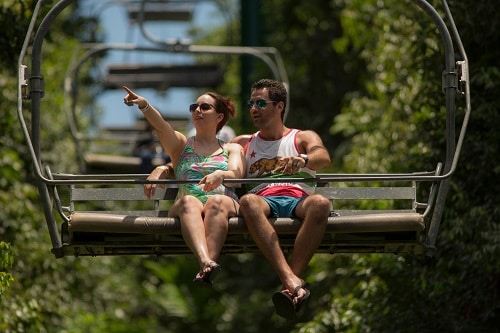
Stateroom Speak
Even before booking your cruise , you’ll want to know the types of staterooms that are available to ensure a comfortable trip. Whether you’re cruising solo or with a group, this list helps you choose the right stateroom for your needs.
- Balcony stateroom: This room has a small, personal, outdoor balcony. A balcony stateroom is recommended when taking a cruise to Alaska , for example, so you don’t miss any unexpected wildlife or glacier sightings.
- Interior stateroom: Located in less active spots on the ship, interior staterooms are comfortable for sleepers who prefer a quiet place to curl up after a day of fun and activities.
- Ocean view stateroom: An ocean view stateroom with a porthole or window lets you gaze out at ocean vistas and ports of calls.
- Specialty stateroom: This has a thematic setting that caters to families, couples or solo guests. Specialty staterooms include Cloud 9 Spa staterooms located next to the Cloud 9 Spa Family Harbor staterooms are next to the Family Harbor Lounge, a great escape when traveling with kids .
- Suite stateroom: Larger rooms that are ideal for family cruises . These suites give everyone in your group ample room to stretch out.
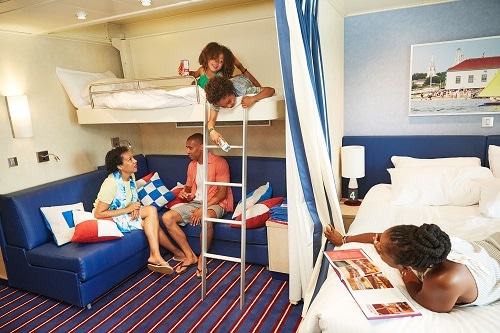
Cruise Ship Terminology
It pays to understand cruise ship terms and definitions so you don’t wander around too much during your vacation. Although, while on board, you’ll never be truly lost. You can find a deck plan of each vessel so you can get to know it before your trip in the comfort of your home. Until then, here’s a crash course in ship architecture.
- Bow: The bow is the front of the ship.
- Bridge: The bridge is the location from which the captain steers the ship.
- Galley: A galley is a ship’s kitchen. On a cruise ship, there are many galleys.
- Gangway: The gangway is the ramp or staircase that you’ll use to embark or disembark the ship.
- Helm: The helm is the area of the bridge on which the steering wheel is located and used by the crew only .
- Hull: The hull is the outside of the ship.
- Keel: The keel is the ship’s bottom center.
- Leeward: The side of the ship where you’ll feel most sheltered from wind is leeward.
- Lido: Lido is an often-used term because it’s the deck where you’ll find the outdoor pools .
- Midship: This is the middle of the ship.
- Port: The left side of the ship as it’s facing forward is called port. If you have a hard time remembering that, just keep in mind that “left” and “port” both have four letters.
- Starboard: The right side of the ship is starboard.
- Stern/aft: This is the rear part of a ship closest to the casual dining
- Upper deck: The upper deck is typically the area closest to the entertainment , fun and outdoor deck areas.
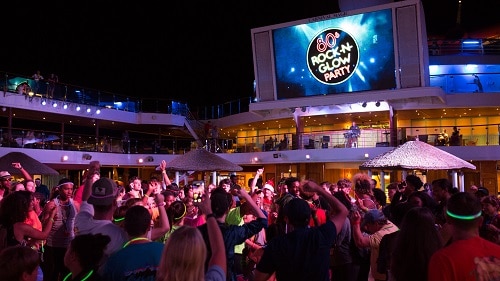
Dining Discussions
- Cruise casual: This is what you can wear most nights at dinner. For men, that includes slacks, khakis, jeans, dress shorts and collared sport shirts. Women wear casual dresses and skirts, pants, capri pants, dressy shorts and dressy jeans.
- Cruise elegant: This is the one or two nights on a cruise where it’s suggested you wear evening wear to dinner in the main dining room and some other restaurants. For men, that means dress slacks, dress shirts and sport coats (optional). For women, it’s cocktail dresses, fancier pant suits or skirts. In restaurants, such as the Steakhouse , you will be required to wear tasteful attire.
- Formal night: There are two formal, or elegant, nights on longer cruises. Elegant nights mean formal suits and ties or tuxedos for men and evening gowns for women. It’s not required to dress formally, yet formal attire is welcome.
- Main seating/late seating: This means there’s an assigned schedule and seating for passengers in the main dining rooms.
- Open seating: There’s no fixed schedule and no seating arrangements for dining with open seating.
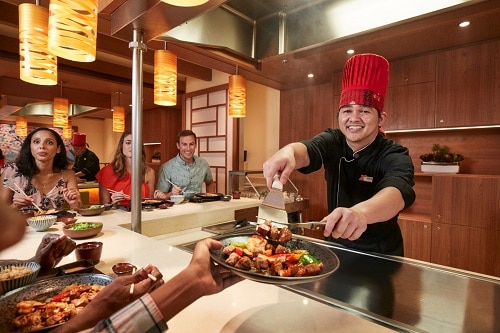
Crew Member Chatter
Who wouldn’t want to be a crew member on a cruise to Hawaii ? Here are some of the cheerful faces you’ll meet on board:
- Cabin steward: Crew member responsible for the housekeeping of your stateroom.
- Captain: Crew member in charge of the cruise ship, responsible for the crew and passenger safety.
- Cruise director: Crew member who organizes for the ship’s activities and entertainment and is often the emcee for onboard events.
- Maître d’: Crew member responsible for the dining room.
- Porter: Crew member on land to help you with your luggage curbside before you embark the ship.
- Purser: Crew member in charge of onboard billing and monetary transactions.
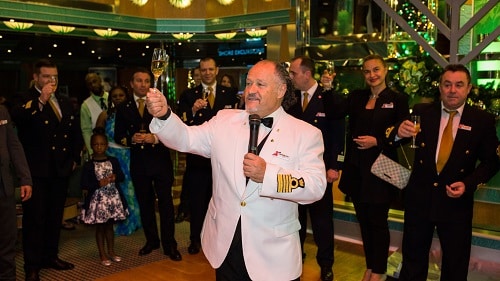
Nautical Lingo
Knowing nautical terms in the cruise ship world is important when you’re underway (which means moving through the ocean). You may hear the captain discussing knots with another crew member.
- Knot: A unit of speed at which ships travel, which is one nautical mile per hour.
- Mooring: A place where a ship is tied, such as the dock when in port.
- Wake: The trail of water created at the back (stern) of the ship as it moves forward in the water.
It’s perfectly fine if you forget your cruise-speak and just say “meet me at the room,” instead of stateroom, or “where’s customer service?” instead of asking to see the purser. On a Carnival cruise, you can just be yourself and learn at your leisure. Once you have your first cruise under your belt, you’ll be well on your way to becoming a seasoned cruiser with insider tips of your own.

Note: Onboard activities, shore excursions, and dining options may vary by ship and destination.
Related articles
What to expect.
https://www.carnival.com/cruise-ships.aspx
- More from M-W
- To save this word, you'll need to log in. Log In
Definition of cruise
(Entry 1 of 2)
intransitive verb
transitive verb
Definition of cruise (Entry 2 of 2)
- gad (about)
- galavant
- kick around
- knock (about)
Examples of cruise in a Sentence
These examples are programmatically compiled from various online sources to illustrate current usage of the word 'cruise.' Any opinions expressed in the examples do not represent those of Merriam-Webster or its editors. Send us feedback about these examples.
Word History
Dutch kruisen to make a cross, cruise, from Middle Dutch crucen , from crūce cross, from Latin cruc-, crux
1651, in the meaning defined at intransitive sense 1
1696, in the meaning defined above
Phrases Containing cruise
- adaptive cruise control
- booze cruise
- cruise control
- cruise liner
- cruise missile
- cruise ship
- radar cruise control
Dictionary Entries Near cruise
Cite this entry.
“Cruise.” Merriam-Webster.com Dictionary , Merriam-Webster, https://www.merriam-webster.com/dictionary/cruise. Accessed 26 Aug. 2024.
Kids Definition
Kids definition of cruise.
from Dutch kruisen "to cruise, move crosswise," from early Dutch crūce "cross," from Latin crux "cross" — related to cross , crucial
More from Merriam-Webster on cruise
Nglish: Translation of cruise for Spanish Speakers
Britannica English: Translation of cruise for Arabic Speakers
Subscribe to America's largest dictionary and get thousands more definitions and advanced search—ad free!

Can you solve 4 words at once?
Word of the day.
See Definitions and Examples »
Get Word of the Day daily email!
Popular in Grammar & Usage
Plural and possessive names: a guide, 31 useful rhetorical devices, more commonly misspelled words, why does english have so many silent letters, your vs. you're: how to use them correctly, popular in wordplay, 8 words for lesser-known musical instruments, it's a scorcher words for the summer heat, 7 shakespearean insults to make life more interesting, birds say the darndest things, 10 words from taylor swift songs (merriam's version), games & quizzes.

What is cruise ship tendering?

If you're new to cruising, you've likely heard of tendering or tender boats, but you might be confused about what they are.
What is a tender on a cruise ship? I'm here to explain (and it has nothing to do with chicken).
What is tendering on a cruise?
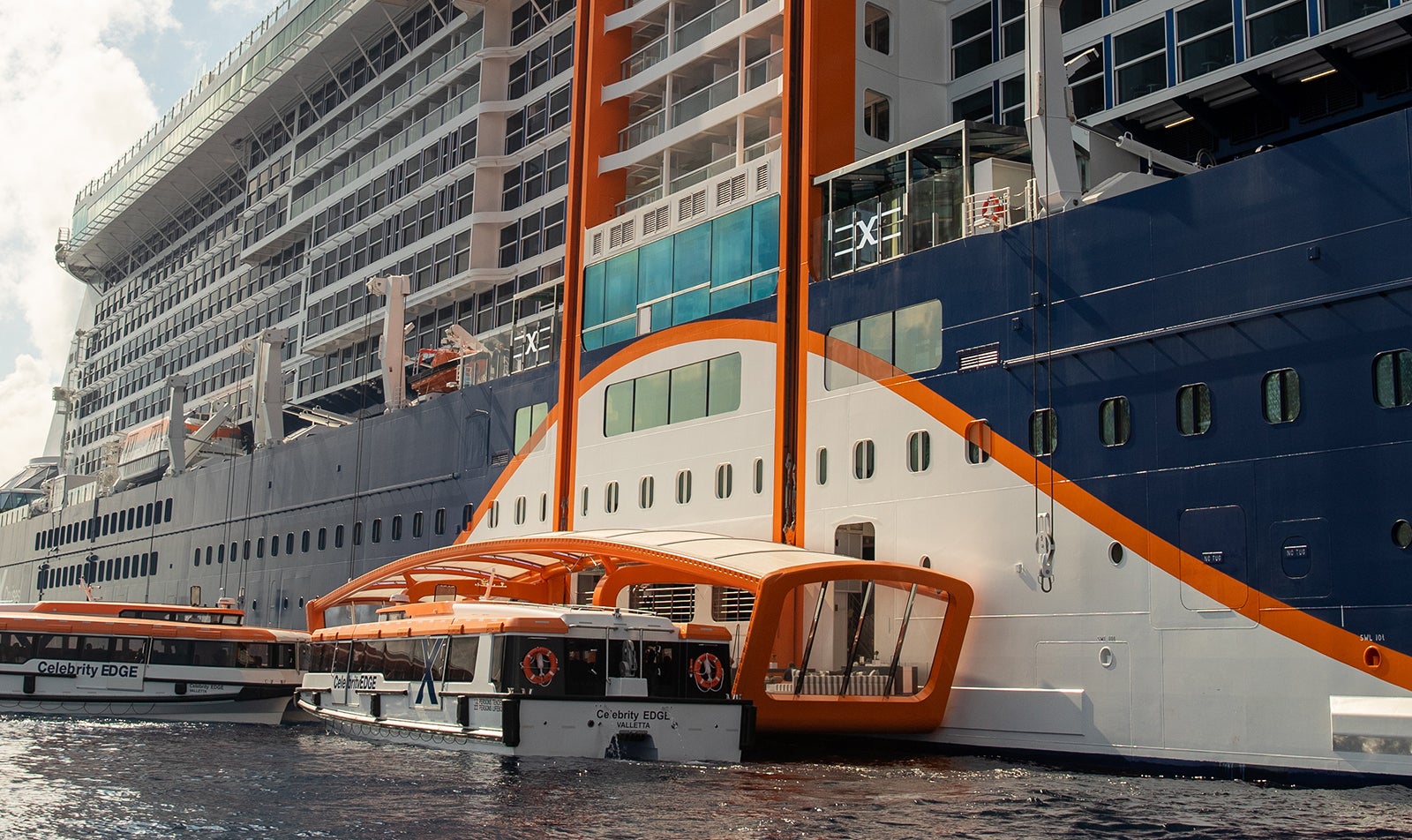
Some cruise ports — including Cabo San Lucas, Mexico; Grand Cayman, Cayman Islands; Santorini, Greece; and Sorrento, Italy — don't allow ships to dock, due to either lack of infrastructure or shallow waters that would cause larger vessels to run aground if they got too close to land.
For cruise news, reviews and tips, sign up for TPG's cruise newsletter .
In other instances, cruise ships will sometimes anchor offshore if ports are crowded and there isn't enough dock space. This often happens in Juneau, Alaska, which has only four berths but can receive as many as six ships in port on the same day.
In those cases, ships anchor offshore and passengers are required to take a cruise ship tender to land. On a cruise, tendering is the process of using smaller boats to ferry passengers from their anchored vessel to shore.
What is a tender boat?
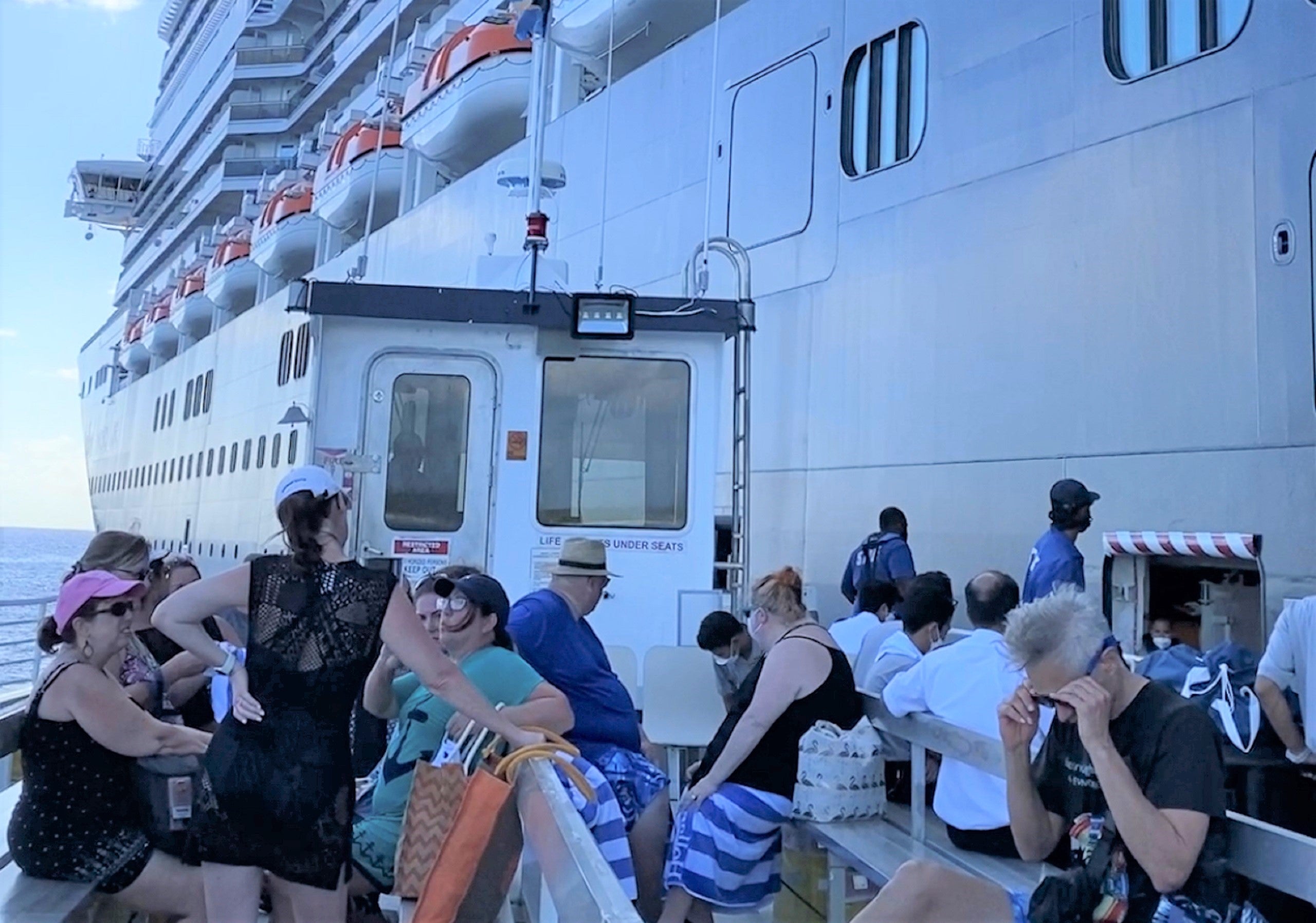
Depending on the port, the cruise line and any local agreements that might be in place, tenders can be boats operated by people who live in the destinations ships visit, or they can be a ship's own lifeboats, which are lowered into the water and used to transport cruisers. Most lines refer to the boats as tenders, but some lines, such as Carnival Cruise Line , prefer the term "water shuttles."
Tender rides are free, but on some larger ships, to keep things orderly and fair, you might have to report ahead of time to get a tender number that will tell you the order in which you can disembark the vessel. Your ship will also let you know what time the last tender boat leaves to return from shore for all-aboard.
Suite guests, cruise line loyalty program members with top-tier status, cruisers booked on early departures of ship-sponsored tours and other VIPs will often be allowed on the first tender boat departures ahead of regular passengers.
Tendering vs. docking on a cruise: Pros and cons
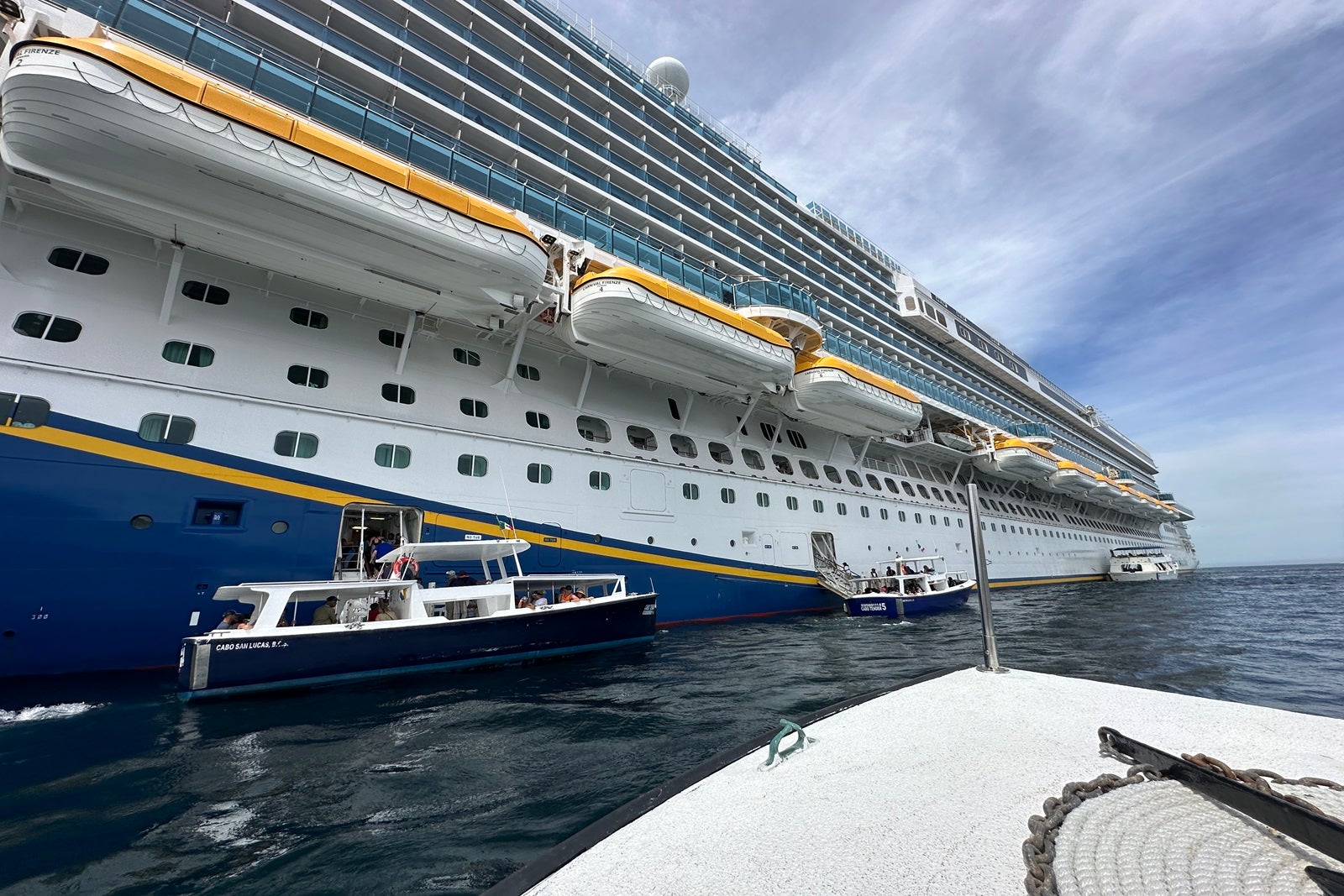
Tendering allows cruise lines to take passengers to a larger variety of port destinations. Water shuttles can provide access to ports you might not be able to visit otherwise because the water is too shallow or they don't have piers equipped to handle cruise ships.
Additionally, if you're a sucker for a great ship photo, tender boats provide a perfect vantage point to snap that scenic ship shot.
While cruise tenders allow ships access to ports without docks, the process does have its downfalls. Passengers with mobility issues, especially those who use walkers, scooters or wheelchairs , might have difficulty boarding the boats as they bob in the water. (In most cases, walkers, scooters and wheelchairs are allowed on cruise tenders, and crew members can offer assistance with boarding tender boats. Check with your cruise line for specifics.)
Tendering also takes time, which means the process of getting ashore will eat into the time you have to explore in port. You might have to wait in a long line for your turn to board.
The boats can be stuffy and crowded, which is a less-than-ideal way to end a fun day of vacation. Cruisers who are prone to seasickness often feel queasy in these water shuttles.
Finally, calls on tender ports can be canceled completely for safety reasons due to inclement weather. If the water is too choppy to allow passengers to board the tender boats safely, the cruise line will skip that port of call.
Bottom line
Tendering on a cruise offers a way for passengers to visit ports where docking facilities are unavailable. You can help to set expectations and mitigate challenges for yourself if you understand that tender ports can be canceled or interrupted due to weather conditions, and they can present challenges for passengers with limited mobility.
If you use a walker, wheelchair or scooter, check with your cruise line to see what its policies are for taking those devices ashore in the event tendering is required.
After you book, many cruise lines list on their itineraries whether each port is a tender port or one where your ship will tie up at a pier. If you have trouble locating that information or need it ahead of booking, reach out to your travel agent or cruise line via the accessibility page on its website.
Got more cruise questions? TPG has answers:
- Man overboard: Why do people fall off cruise ships?
- What is baked Alaska, and why is it paraded around cruise ships?
- What are the largest cruise ships in the world?
- What is a gentleman host on a cruise?
- What is the Jones Act and how does it affect cruise ships?
- What is a lido deck on a cruise ship?
- What's a cruise cabin guarantee and will it save you money?
- What's the difference between a cruise concierge and a butler?

IMAGES
COMMENTS
Cruise lines operating in the Caribbean include Royal Caribbean International, Princess Cruises, Carnival Cruise Line, Celebrity Cruises, Disney Cruise Line, Holland America, P&O, Cunard and Norwegian Cruise Line. There are also smaller cruise lines that cater to a more intimate feeling among their guests. The three largest cruise operators are ...
cruise ship: [noun] a large ship that stops at different ports and carries passengers who are traveling for pleasure.
April 29, 2021. A cruise ship is a luxury vessel that is used to take passengers on a pleasure voyage in a journey that is as much a part of the experience as the various destinations on the way. In contrast to an ocean liner that transports passengers from one point on the globe to the other often across the oceans, a cruise ship or a cruise ...
A cruise ship is a luxurious passenger ship used for recreational and pleasure voyages and has all the amenities, entertainment options, activities, and attractions present only for the purpose of enhancing the passenger's experience. A cruise ship usually takes a round trip of a particular route that is assigned to it and unlike an ocean ...
CRUISE SHIP definition: 1. a large ship like a hotel, that people travel on for pleasure 2. a large ship like a hotel, that…. Learn more.
Cruise ship definition: a passenger ship built or used for pleasure cruises, usually taking passengers on an extended cruise with occasional calls in various places of interest.. See examples of CRUISE SHIP used in a sentence.
1 ENTRIES FOUND: cruise ship (noun) cruise ship noun. plural cruise ships. Britannica Dictionary definition of CRUISE SHIP. [count] : a large ship that takes many people on a cruise at one time : a large ship that stops at different ports and carries passengers who are traveling for pleasure. — called also cruise liner.
A cruise tour package may be defined as a systematically planned return journey with entertainment and recreational facilities on board, and shore excursion. In other words, the cruise package is a pleasure an all-inclusive trip by boat or ship for specific days, to specific days, to specific destinations, and with a set price.
Icon of the Seas is the first ship of Royal Caribbean's Icon class of cruise ships, and the largest cruise ship in service since late January 2024. Wonder of the Seas is the fifth ship of Royal Caribbean's Oasis class of cruise ships and is the third largest cruise ship in service as of August 2024.. Cruise ships are large passenger ships used mainly for vacationing.
The Simple English Wiktionary has a definition for: cruise. A cruise ship (or cruise liner or ocean liner, though the latter mainly refers to large vessels designed for mass leisure travel which cross the ocean [ 1]) is a large ship with sleeping cabins and other facilities that takes people on holiday and vacation trips.
Luxury cruise lines: Oceania, Windstar, Azamara, Hapag-Lloyd, Ponant/Paul Gauguin, Fred. Olsen, Saga ### Ultra-luxury cruise lines take the luxury cruise line experience and add even more sophistication and pampering. These tend to be all-suite ships that offer "all-inclusive" packages, meaning everything from the lodging to the dining, drinks ...
Knots: Knots are a unit of speed used by ships and are short for nautical miles per hour. One knot is equivalent to 1.15 land miles per hour. Cruise ships have cruising speeds of around 22 knots.. Provisions: Refers to supplies needed on the ship Lock: A device used to raise and lower ships between stretches of water at different levels. Zodiacs: Small inflatable boats used for water bases ...
CRUISE SHIP meaning: 1. a large ship like a hotel, that people travel on for pleasure 2. a large ship like a hotel, that…. Learn more.
Wake. A ship's wake is the visible trail of disturbed water that is left behind a moving vessel as it travels through the water. Wake views are some of the most desirable on a cruise ship, often with aft-located bars and lounges to admire the views. 16. Knot. A knot is a unit of speed at which ships travel.
The SS Ceylon was the first vessel repurposed to be a cruise ship. It was owned by the London-based ship brokerage Culliford & Clarke, which hoped to make cruising the centre of its business. The Ceylon was a single-screw, iron-hulled auxiliary steamer—meaning that it had both a steam engine and sails—and could hold up to 100 passengers. Its renovation had removed several dozen passenger ...
The largest designated cruise ship as of present-day is the very recent Wonder of the Seas, with a whopping gross tonnage of 236860, a length of over 360 meters, a width of 65 meters, and can accommodate nearly 7000 passengers on board! Launched in January 2022, it is slated to create history by embarking on its maiden voyage in March.
A cruise line is a company that operates cruise ships that operate on ocean or rivers and which markets cruises to the public. [ 1] Cruise lines are distinct from passenger lines which are primarily concerned with transportation of passengers. Though cruise packages provided by cruise lines vary, there are some features most have in common ...
Porter: Crew member on land to help you with your luggage curbside before you embark the ship. Purser: Crew member in charge of onboard billing and monetary transactions. Nautical Lingo. Knowing nautical terms in the cruise ship world is important when you're underway (which means moving through the ocean).
A cruise ship is a passenger ship that sails to a number of different destinations with the pleasure of the voyage being entirely the point. Cruise ships are synonymous with being luxury vessels and their amenities, activities, drinking and dining options, and entertainment are all created with the passenger's experience in mind.
Cruise Ship definition: A ship used to carry groups of tourists from port to port on a designated route and usually equipped to entertain them lavishly along the way.
cruise: [verb] to sail about touching at a series of ports.
Check with your cruise line for specifics.) Tendering also takes time, which means the process of getting ashore will eat into the time you have to explore in port. You might have to wait in a long line for your turn to board. The boats can be stuffy and crowded, which is a less-than-ideal way to end a fun day of vacation.
Cruise ships. Demand for cruising has expanded rapidly from the 1980s, leading to a new generation of large and luxurious ships. Cruise ships are designed for the purpose of providing passengers with a holiday including accommodation and entertainment prioritising onboard amenities and comfort. Unlike the traditional ocean passenger liner, they ...